Gregory To Take Over From Gennaro as Dean

challenges that lie ahead.”
Gregory will return to CSON, where she received her doctorate in 2006, after a career pursuing innovative lab work, working in hospital leadership, and educating a generation of health care workers, the release said.
VICTOR STEFANESCU Asst. News Editor
Katherine E. Gregory will take over as dean of the Connell School of Nursing on July 1, according to a University release.
Gregory currently serves as the associate chief nursing officer for women’s and newborn health, research, and innovation at Brigham and Women’s Hospital.
Gregory, who was previously an associate professor in CSON and is currently an assistant professor of pediatrics at H arvard Medical School, will replace Susan Gennaro as dean. Gennaro is s tepping down from the post after 13 y ears and will remain on the school’s faculty, a release announcing Gennaro’s departure said.
“Boston College has a long history of preparing nurses who make a difference, whether they serve at the bedside, in the classroom, as scientists developing new k nowledge for practice, or as leaders in their local and global communities,” Gregory said in the release. “... As dean, I plan to partner with many others, successfully contributing to the mission of Boston College and leading the Connell School through the opportunities and
In her 25 years as a nurse at Brigham and Women’s Hospital, Gregory rose from a staff nurse in the newborn intensive care unit to associate chief nursing officer, where she oversees a staff of approximately 700 nurses and clinical personnel, the release said.
Gregory also serves as senior nurse executive on the hospital’s Executive Advisory Council for Diversity, Inclusion, Health Equity, and Community Health.
In her position at Brigham and Women’s, Gregory has worked closely in partnership with CSON, according to Colleen Simonelli, a member of the dean search committee and associate dean of undergraduate programs in the nursing school.
“With her vision for creating a more diverse, inclusive, and equitable nursing workforce, Kate is uniquely positioned to advance the mission of the Connell School,” Simonelli said. “Bringing together our clinical and research faculty with our colleagues and partners across campus, I am confident Kate will lead us to new heights.”
See CSON, A2
Runners Struggle Without Marathon
JULIA REMICK Metro Editor
2020 was a year of cancellations and not even the Boston Marathon could outrun the COVID-19 pandemic. This year, Bostonians will face yet another Patriots’ Day without the historic race.

For the first time in its 124-year history, the Boston Marathon was not held in April of 2020, and then-Boston Mayor Marty Walsh, BC ’09, instead moved the event to Sept. 14.
Following its initial postponement, Walsh canceled the 124th race that was
set to take place in person. Instead, the marathon took place virtually from Sept. 7 to Sept. 14.
There were 17,952 people registered to participate virtually in the 124th race and 15,972 marathoners who submitted their times, according to a press release from the Boston Athletic Association (BAA).

Heartbreak Hill will again be empty this Patriots’ Day, following the BAA’s announcement that the 125th marathon will take place on Oct. 11. This is contingent upon the Commonwealth’s reopening plan proceeding as planned
and permitting road races by that time, according to the BAA.
Boston is currently in Phase 4 Step 1 of reopening, and road races are slated to be permitted during Phase 4 Step 2 of the reopening plan.
The field size for the race will be limited to 20,000 entrants in order to allow for social distancing throughout the course, according to a press release from the BAA on March 15. The field size for the marathon in 2019 allowed for 30,000 entrants. See Marathon, A4
BC After Dark Opens
5 p.m. until midnight, and Fridays and Saturdays from 4:30 p.m. until midnight.
Crowds overwhelmed the restaurant on the Thursday night grand opening, causing food orders to fall 40 minutes behind, according to an Instagram post from the Undergraduate Government of Boston College, who partnered with BC Dining to open the restaurant.
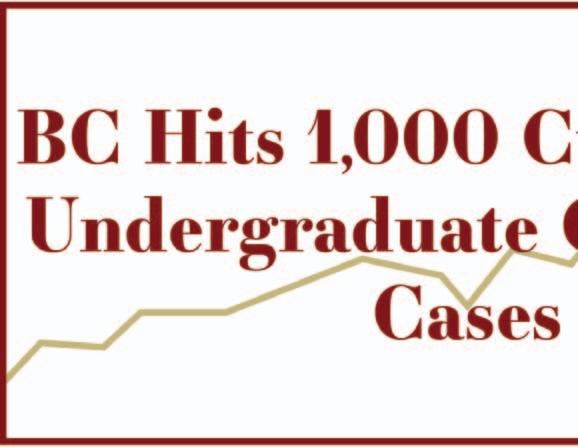

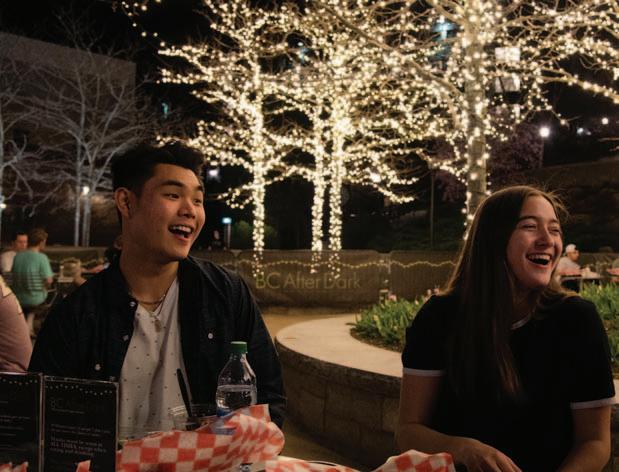
BC After Dark served up burgers right off the grill, salt-dusted curly fries, and hummus platters for its opening weekend—all for half off. But the freshly grilled food is not all that drew the crowds on the warm spring weekend, according to Brendan Barnard, MCAS ’21.
“I mean [the drinking] is why we came,” Barnard, who visited the new on-campus restaurant on Saturday night, said.
BC Dining will be serving beer, wine, and spiked seltzers alongside a variety of food offerings in the restaurant retrofitted in Hillside Cafe on Thursdays from

“People are having a good time and a safe time,” Molly Denning, one of the attendees and MCAS ’24, said. “The only issue was that since it was so fun and popular, more people came than the y planned which is why they fell behind. Maybe they could just put a cap on the orders in the future.”
The restaurant features a fenced-in seating area outside Hillside, which is covered by a canopy of trees wrapped in bright holiday lights. UGBC slashed food prices in half for opening weekend, offering burger costs that rivaled those of fast food joints.
SPORTS
North set the record for goals scored in a single game, beating Sam Apuzzo’s previous record with 10 goals against Virginia Tech. A12

Back On Track
INSIDE THIS ISSUE MAGAZINE: John Acampora Flat Breads owner has served the BC community for almost 30 years................ A5 MAGAZINE: Quarantine Kitchen This week, Alexandra Morin whips up tasty carne asada bowls............................................. A8 INDEX Vol. CII, No. 8 © 2021, The Heights, Inc. www.bcheights.com NEWS...................... METRO..................... MAGAZINE.................. OPINIONS.............. ARTS.................... SPORTS................ A2 A4 A5 A6 A9 A12 Monday, April 12, 2021
Katherine Gregory will become the new CSON dean.
BC Softball captured two wins over Syracuse in its doubleheader on Saturday to snap its weeks-long losing skid.
IKRAM ALI / HEIGHTS EDITOR
LACROSSE
QUADSTOCK
ARTS
A9
BC’s musicians had the opportunity to showcase their talents at the in-person CAB event.
ADA ANDERSON Heights Staff VICTOR STEFANESCU Asst. News Editor
The new dining service was a crowd-pleaser on opening night.
A3
See After Dark,
IKRAM ALI / HEIGHTS EDITOR
PHOTO COURTESY OF DREW KIRAKOFE
GRAPHIC BY ÉAMON LAUGHLIN / HEIGHTS EDITOR
BRIEFS
BC Accepts Class of 2025
BY EMMA DAWSON Heights Staff
Boston College accepted 18.9 percent of a record-high 39,875 applicants for the Class of 2025, according to a University release.
This reflects a significant increase in the University’s admission selectivity from last year’s 24 percent acceptance rate.
Director of Undergraduate Admission Grant Gosselin praised admitted students for their resilience amid the pandemic that has upended much of their high school career.
“The students embraced the challenge as an opportunity and, in the process, many discovered a newfound appreciation for what the world needs of them,” Gosselin said in the release.
This year’s admitted class is the most diverse in BC’s history, with 42 percent AHANA students, 11 percent first-generation students, and seven percent international students, the release reads.
This was the second admission cycle in which the University used Early Decision (ED) I and II instead of Early Action, meaning that ED applicants—who were notified of their statuses in December and February, respectively—immediately commit to attending BC if accepted.
Regular Decision applicants were notified of their status on March 25.
Maame Twum-Barima, who plans to study sociology and psychology on the pre-med track, said she was excited when she found out she was admitted to BC. She said she is eager to get involved in campus life.
“I feel like I found the perfect place for me,” Twum-Barima said.
Due to the COVID-19 pandemic, Twum-Barima was unable to visit BC’s campus before applying.
The New Jersey resident said she still felt that she was able to learn about the many ways students can get involved on campus through virtual admissions programming.
Maria Wills—a student from Mullica Hill, N.J. who plans to major in biology—realized BC was her dream school while on a campus tour during her sophomore year of high school.
“I actually cried at the end of it,” Wills said. “It was just so beautiful!”
BC was one of several universities that was test-optional for this admissions cycle. Despite this change, 61 percent of BC’s accepted students submitted their scores, with an average SAT score of 1495 and ACT of 34, according to the BC release.
Arjun Garg, an admitted student from New Delhi, India, said he was grateful that BC became test-optional.
“I actually registered for the SAT twice, but they both got canceled, so I had to apply test-optional,” he said.
Despite BC being test-optional, admitted students said that they felt they were able to show they were qualified through other elements of BC’s application.
BC accepted students from 3,168 high schools across all 50 states and 75 countries to the Class of 2025, according to the release. Fifty-four percent of admitted students come from public and charter schools, 20 percent come from Catholic schools, and 26 percent come from private or independent schools.
Gosselin said in the release that BC is fortunate to be viewed as one of the leading universities in the country.
“Prospective students look to BC for our rich history of liberal arts education steeped in the Jesuit tradition, the social impact our students and alumni make on the world, and our continued physical and programmatic growth at a time when so many universities have been forced to cut back,” he said.
Racist, Homophobic Vandalism in Williams Hall
BY MEGAN KELLY News Editor
A non-Boston College student allegedly tore down a Black Lives Matter flyer and an LGBTQ+ pride flag from the door of a resident assistant’s (RA) room in Williams Hall on April 2, according to an email from Director of Residential Education Dorrie Siqueiros to Williams residents.
One resident intervened and stopped the vandalism, Siqueiros said in the April 3 email, and the BC Police Department caught the person responsible, who is a student at a Midwestern college.
“BCPD is investigating the incident and will consult with outside authorities as appropriate,” she wrote. “In addition, Boston College will forward information about this incident to the individual’s school for potential conduct action.”
Siqueiros also said that the alleged bias incident was filed with the Office for
Institutional Diversity, and it encouraged students to come forward and contact the resident director, an RA, or BCPD if they had any more information about the incident.
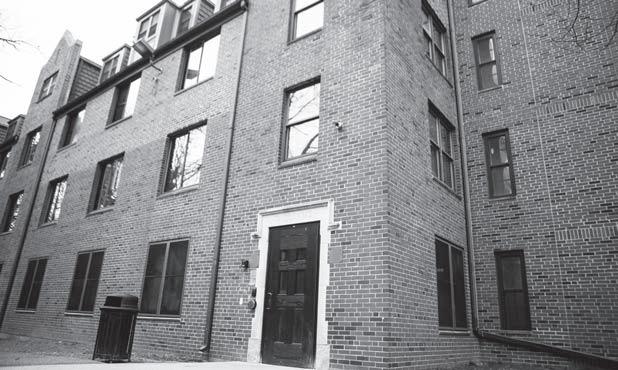
“This incident serves as an important reminder that non-BC students are not permitted to be in residence halls during the pandemic, and any students who invite guests to campus are responsible for their conduct,” she wrote.
Associate Vice President for Student Engagement and Formation Tom Mogan emphasized BC’s commitment to addressing all incidents of bias-motivated behavior in an email to The Heights
“I would reaffirm that the University takes seriously any incidents of bias motivated behavior and students found responsible will be held accountable through our Conduct system,” Mogan wrote.
Siqueiros did not respond to The Heights’ request for comment.
In the email, Siqueiros encouraged the Williams residents to utilize the resources available in the Division of Student Affairs, and contact their RAs and RD if they need personal support in light of the incident.
“It is our mission within Residential
Life to create caring, welcoming, and inclusive communities for students from all backgrounds, experiences, and identities at Boston College,” Siqueiros wrote. “There is simply no room for the behavior that occurred.”
Nursing Students To Conduct Clinics in Maine
B Y A MY P ALMER Asst. News Editor
The Connell School of Nursing (CSON) will be conducting wellness clinics from April 19 to 23 in Aroostook County, Maine. Nursing students will also be conducting home visits, setting up vaccine clinics, conducting COVID-19 testing, and assisting in a blood drive.
Nineteen nursing students—who were initially planning to serve in Jamaica and Chile—alongside five nurse practitioner students and faculty, will be traveling to Presque Isle, Caribou, Houlton, and Madawaska, and setting up the wellness clinics in churches, according to clinical assistant professor Donna Cullinan.
The wellness clinics will feature tables on pain management, nutrition, domestic violence and safe plans, women's health, mental health, substance abuse, and more, Cullinan said.
“BC being a Jesuit Catholic university, we are in alignment with how we treat the whole person from health of their body to spiritual health and mental health issues,” Cullinan said.
The students will also have the opportunity to use triage to allow community members to convey their health needs, according to Maggie Shea, CSON ’21. The nurse practitioner students will diagnose problems and give non-prescription medicine. Students will also supply recipes, gift cards, and various health supplies to community members.
Kelly Day, director of volunteer services at Catholic Charities Maine, said that this has been a collaborative effort between many members of CSON, Catholic Charities, Maine Public Health Nursing, Cary Medical Center, and Holy Rosary Parish.
“It's a really great team effort at the
health fairs,” Day said. “There's going to be all kinds of great things going on.”
Cullinan, who has been taking students to Haiti for over 10 years, was planning a trip to Jamaica this year, but was unable to do so because she said Jamaica did not allow people to enter who were not vaccinated for COVID-19.
Still, Cullinan wanted the nursing students to have an experience serving in under-resourced areas. After reaching out to Catholic Charities and Maine Public Health, Cullinan and some colleagues have been meeting with the organizations weekly to organize the trip.
“We've formed this really great partnership, and we're modeling it with some adaptations to what we have done for years in Haiti,” Cullinan said.
Cullinan said Aroostook County is a great place to serve because the students will have the opportunity to work with people in an under-resourced area.
“They have great need,” Cullinan said. “I think it's a really rural area, there's a lot of poor there that don't have access to cars and medical help. So that's what we were looking for.”
Day said she is excited for the nursing students to serve the community and is looking forward to the communities’ responses.
“I think it's gonna be great because we have our own medical facilities in Maine, but it's kind of nice to have people that are studying at Boston College come up, because they'll have a whole different way of looking at things, or maybe a whole different skill set that they can share with the people in northern Maine,” Day said.
Shea, who was initially going to Jamaica, said this trip will be a great learning experience.
“[W]e also all have experience in these amazing hospitals here but that have so many resources and that's
not really what health looks like for everyone,” Shea said. “So, it'll be a really educational experience, I think, to be in a place where that isn’t the norm.”
Erin McMahon, a nursing student who was set to go on the Chile trip, said she is excited about serving in Aroostook County and experiencing community health nursing.
“I think it's gonna be a really amazing opportunity to become immersed into a new community and just like really get a feel for what public health and community health nursing is like,” McMahon, CSON ’21, said.
Jeffrey Heredia, CSON ’21, said that he is excited for the opportunity to grow as a nursing student.
“I'm also excited to learn both as a nursing student and in my role to become a professional nurse,” Heredia said. “I think it's going to give me the skills and assets that I would need to keep representing and keep serving those communities in need, which is my goal in life.”
CSON Dean Susan Gennaro said that conducting wellness clinics is extremely important to health promotion.
“We're very interested in what our nursing staff can do to help improve health and health promotion,” Gennaro said. “Wellness clinics are a great thing. You shouldn’t always wait until people are sick.”
Day said that Catholic Charities has been very supportive of the work the nursing students will be doing and will be making dinners for the nursing students every night of the trip.
Cullinan is grateful for the generosity of the parishioners and the service the nursing students will be providing.
“The parishioners … could not be more hospitable and grateful for what we're doing.” Cullinan said. “I feel like they're helping us out for my students to meet the goals of population health
and have an experience, and I think they feel the same way, but we're just being so generous in what we're supplying and doing so it's like a win-win for everybody.”
Gennaro said that developing a long-lasting relationship with the communities in Maine is especially important for the students during this trip.
“We're very interested in sustainable relationships and working with populations that help our students to learn, but also where possible, help with the mission of Boston College being men and women for others and really trying to decrease disparities,” Gennaro said.
As a senior, Shea is excited to apply what she’s learned through her education to the Maine community.
“I think it will be a really great way to take like four years of nursing education to a community,” Shea said.
Being able to serve others in Maine is also a great way to align with the Jesuit values of BC, McMahon said.
“I think it's like a really great way to put others before yourself, kind o f like aligning with Jesuit values and everything like that,” McMahon said. “So I think it's going to be really interesting, and I'm going to learn a lot from it for sure.”
Cullinan hopes her nursing students learn to always care for people around them, not just on service trips like this one but in their everyday lives.
“Students are lucky to go to Boston College and experience what we have and what we have to give,” Cullinan said. “And my hope is that they may not always go to Maine or Jamaica or Haiti every year, but that forever they will take care of people in their neighborhood by checking on the woman next door or volunteering in other capacities and to always give back, especially with their knowledge of health and everything."
Katherine Gregory Tapped for Dean of CSON
CSON, from A1
As a researcher, Gregory has secured funding from both the National Institutes of Health and National Institute of Nursing Research from 2003 through 2024, according to the release. She also helped establish BC’s Haley Nurse Scientist Program in 2009, which funds scholarly activities of both CSON faculty and clinical nurses at Brigham and Women’s Hospital.
Gregory serves as an assistant in biology in the Mucosal Immunology Lab at Massachusetts General Hospital and as a senior scientist in pediatric newborn medicine at Brigham and Women’s, according to the release. She is also the editor of the Journal of Perinatal and Neonatal Nursing.
Provost and Dean of Faculties David Quigley said in the release that Gregory’s experience as a nursing leader and previous time at BC makes her well prepared to serve as dean.
“As someone who did her doctoral work here and then served on the faculty, Kate speaks powerfully about what makes Boston College such a special place,” Quigley wrote. “Her impressive research program, the leadership she has provided at Brigham and Women's Hospital, and her innovative approaches to nursing education and scholarship make her the ideal candidate to guide the Connell School starting this summer.”
Before Gregory’s studies at BC, she received a bachelor’s degree in nursing from Binghamton University and a master's in nursing from the University of Pennsylvania. As a CSON faculty member, she received an award for Student Mentorship and Leadership Development and another for Excellence in Teaching and Research, the release said.
Christopher Lee, member of the dean search committee and associate dean for research of CSON, said Gregory’s forward-looking focus makes her the
right leader for CSON.
“Dr. Gregory has a strong and forwardlooking vision for the future of the Connell School that will preserve the Jesuit, Catholic traditions that were formative in her own education,” Lee said in the release.
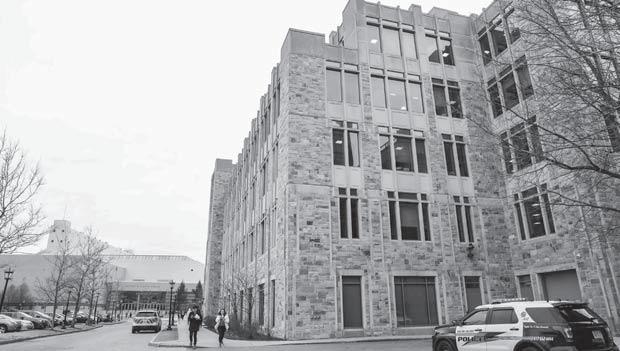
Gregory said her vision for CSON is to prepare nurses that look to improve
human health in many different ways.
“As dean, I will work closely with the community of the Connell School and Boston College, as well as with leaders across Boston and beyond, to ensure that we prepare nurses to serve patients, families, and communities in many capacities, but always as people for others,” Gregory said.
THE HEIGHTS A2 MONDAY, APRIL 12, 2021 TOP things to do on campus this week 3 NEWS
1
2 3
On Wednesday at 7 p.m., former NBA player Chris Herren will speak at a virtual event hosted by the Campus Activities Board. Herren will share his life story overcoming struggles with substance abuse and his path to educating thousands across the country.
Ben Rattray, the founder and CEO of Change.org, will speak at the annual Brennan Symposium for Student Leadership and Ethics on Thursday at 6 p.m. The lecture, titled “Mobilizing Youth to Change the World,” will be hosted by the Winston Center for Leadership and Ethics.
The Owen M. Kupferschmid Holocaust/ Human Rights Project will be hosting its annual memorial lecture on Thursday at 12 p.m. The lecture is designed to address legal issues related to the Holocaust and other human rights violations.
IMAGE BY IKRAM ALI / HEIGHTS EDITOR
The alleged incident took place in Williams Hall on College Road.
MAGGIE DIPATRI / HEIGHTS EDITOR
The Boston College Connell School of Nursing is based in Maloney Hall on Lower Campus.
BC Surpasses 1,000 Undergraduate Cases
 BY MEGAN KELLY News Editor
BY MEGAN KELLY News Editor
Boston College reported 33 undergraduate cases of COVID-19 out of 13,654 tests this past week, a positivity rate of .24 percent, according to the University’s COVID-19 dashboard.
Eighty-six undergraduate students were in isolation as of Friday, with 43 in isolation housing and 38 recovering at home.
This past week, the University also surpassed 1,000 undergraduate cases of COVID-19, with a total of 1,010 undergraduates having tested positive out of 224,183 tests this academic year, a positivity rate of .45 percent.
The positivity rate this week marks a significant drop from the previous week’s rate of .75 percent, with 72 undergraduate cases out of 9,641 tests.

In a March 23 University release, Associate Vice President for Student Engagement and Formation Tom Mogan reminded students to preregister for a COVID-19 vaccination appointment in Massachusetts, as the
University has been unable to secure vaccine doses from the state.
“Boston College has inquired about the acquisition of vaccines; however, the Commonwealth of Massachusetts does not appear to have any current plans to distribute vaccines to colleges,” Mogan wrote.
Around 25 percent of Massachusetts’ population is fully vaccinated, and about 41 percent has received their first dose of the Pfizer or Moderna vaccines as of Sunday, according the Massachusetts Department of Public Health. The Commonwealth is now ranked 10th in the country in percentage of vaccines administered.
Mogan reminded students in the release to continue following social distancing guidelines and COVID-19 safety protocols.
“I thank you again for everything that you are doing to ensure that we maintain a safe and healthy learning environment on campus,” Mogan wrote. “We ask that you remain vigilant so that we can finish out the last few months of the semester on a strong note.”
Cheap Food, On-Campus Drinks Draw Students to BC After Dark
Christian Guma, UGBC president and CSOM ’21, said in an email to The Heights that seniors were central to the creation of BC After Dark.
“Trying to score victories for the seniors was a priority of mine,” Guma said. “The dining team had a similar goal, it turns out. They had been eyeing up something like this since before we got into the picture. It seemed like now everything aligned perfectly to get it done.”
Kevork Atinizian, UGBC vice president and CSOM ’22, said in an email to The Heights that BC After Dark is a COVID-19-safe alternative to risky off-campus bars.
“As the fall progressed we noticed that campus morale was low, and students were going off campus and into bars which posed a risk to everyone,” Atinizian said. “In every meeting we had with administrators we brainstormed ideas as to how we could keep students on campus while lifting morale at the same time.”
Before BC After Dark, there were no on-campus food options for students on Fridays and Saturdays open after 8:30 p.m. this semester. Parents complained to BC Dining about limited hours of operation at dining halls at a Zoom meeting in October.
“It’s good weekend food because BC Dining’s weekend food literally sucks so hard,” Stephanie Barry, MCAS ’23, said.
Aside from being open late, many students found the fact that BC After Dark is on campus compelling.
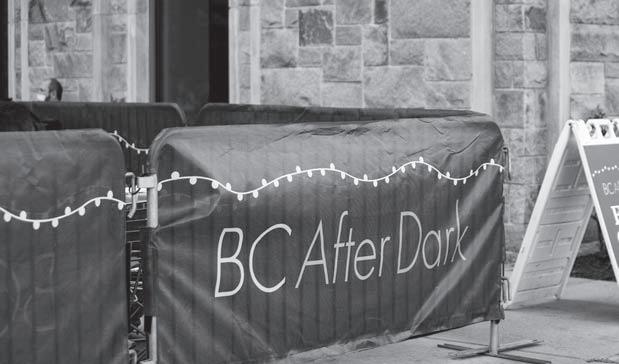
“I think this is very distinct, and respect to BC Dining for pulling something like this off,” Barnard said.
Guma said the restaurant offers students a reward after a year of commitment to UGBC’s #KeepTheHeightsHome campaign, which urged students to follow safety protocols to protect the BC community from COVID-19.
“I look forward to seeing my fellow students enjoying themselves,” Guma said. “It’s been a tough year, there’sno
question—so to be able to see your friends and fellow classmates having fun is going to be pretty awesome. The students deserve this for the job they did in staying safe and ‘Keeping the Heights Home.”’
Students were required to make reservations and pick up their pre-ordered food on the way in, before ordering drinks.
“Due to the capacity limits, along with the state law requiring a purchase of food before buying alcohol, students will need to reserve a time slot through GET Mobile,” Guma and Atinizian said in the email.

Although many students enjoyed their experiences at BC After Dark, some had a few suggestions. Barnard said BC Dining should consider playing music at the restaurant and making the prices of alcohol cheaper.
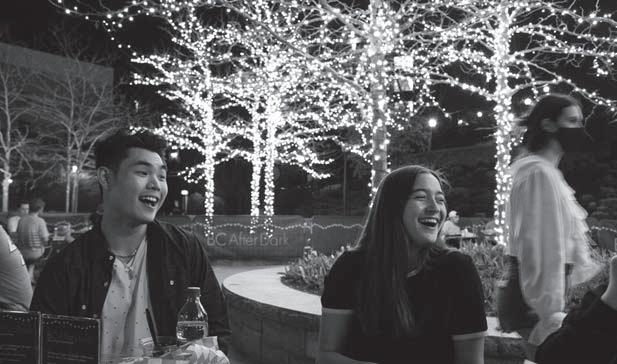
“Yeah, it seems like if they made it like more of a bargain, … maybe some music could go a long way,” he said. “I don’t know, it needs some work.”
Barry said that although there was a nearly 30-minute wait time for her food, she understands that opening a ne w restaurant never goes exactly to plan.
“I think they were working out the kinks of a new restaurant,” she said.
Barnard said that despite the prices and lack of music, he looks forward to returning to BC After Dark in the future.
“I think BC After Dark is still a work in progress but I’m excited to see the final form,” Barnard said.
Barry said she hopes to see BC After Dark return in coming academic years.
“I kind of hope it becomes a permanent thing,” Barry said. “It was really nice.”
Law Professor Defends Masking in ‘The Case for Masks’
BY JULIA LANDWEHR Heights Staff
Spring has arrived in New England— the weather’s getting warmer, and people are looking for opportunities to get together again after months indoors. The idea of Boston coming alive for the sunny weather may tempt residents to leave the house without a mask and gather in groups with the lower halves of their faces free.
Dean Hashimoto, BC law professor and chief of occupational and environmental medicine at Massachusetts General Hospital and Brigham and Women’s Hospital, can empathize with the sentiment.
“We all can very justly complain about having to wear masks,” Hashimoto says. “They’re uncomfortable, they stifle our breathing, they’re a general nuisance.”
It’s with this empathy that Hashimoto begins his book, The Case f or Masks , which was released last October. Using his legal and medical background, Hashimoto tries to cut through partisan rhetoric around the COVID-19 pandemic, and argues for the importance of masking in the United States.
The book is all about meeting people
where they are, he said, and offering a practical, science-based argument as to why every person in the United States should wear masks.
“The point is not to get 60 percent of the country to agree,” Hashimoto said.
“Rather, the point of the book is to try to get 95 percent of the country to agree, which is the number we need to have an effective universal masking program.”
He wants the book to spark meaningful conversations that will promote what he calls “a culture of safety,” where people are willing to take necessary measures in order to live safely during the COVID-19 pandemic.
For Hashimoto, that means wearing masks.
The Case for Masks was born out of data from Massachusetts General and Brigham and Women’s hospitals, one of the first hospital systems in the country to institute a masking program in March 2020, Hashimoto said. It saw a dramatic decrease in the number of infections soon after putting this mandate in place.
For Hashimoto, this provided strong evidence for the importance of masking, not just in hospital settings, but wherever people gather, he said.
“What we found is that masking by
itself was such an effective measure that it essentially reduced and diminished workplace exposure to zero, despite the fact that social distancing was very difficult to enforce, if at all, in patient care areas,” he said.
An overwhelming majority of maskwearing Americans would, according to Hashimoto, mean two things: an opportunity to increase capacity in indoor spaces, even in spaces where social distancing might not be possible, and a possibility of squashing COVID-19 altogether.

“If we were able to coordinate all the state mandates for masks, and put something into place for six to eight weeks, you know, a couple months, if we were able to do that, we could make this pandemic disappear with a vaccination rate of about 50 percent,” Hashimoto said. “And 50 percent, I think, is very reasonable for this country.”
Even though the vaccine rollout in the United States, especially in Massachusetts, is going well, Hashimoto said he still believes that masks are a more reliable public health strategy.
“If you look at vaccines, even ones that are 90, 95 percent effective, you’re going to need to vaccinate 80 to 90
percent of our population,” Hashimoto said. “And that’s not going to happen in the foreseeable future in this country, much less other countries in the world.”
A recent poll sponsored by The Marist Poll in partnership with NPR found that 25 percent of Americans say they won’t get the vaccine, and another 5 percent are unsure. Vaccine hesitancy has become an obstacle to the herd immunity that’s necessary to overcome the pandemic and get life back to normal, Hashimoto said.
Mask wearing, Hashimoto said, is a relatively moderate and simple public health solution to the COVID-19 problem. It’s also low-cost compared to vaccinations, and it can be a useful way to decrease health disparities.
“The groups that were harmed the most, that suffered the greatest casualties from this pandemic, were basically the poor and minorities,” Hashimoto said. “And, the vaccination program isn’t helping that, not the way that we’re handling it right now. We’re discovering that the least vaccinated groups are exactly those groups.”
Hashimoto is encouraged by the Biden administration’s rhetoric around the importance of masking, but he said he would like to see a larger investment
to improve mask technology and to make masks free and accessible in communities that need them. Though most cloth masks worn by the average American are about 70 percent effective at filtering virus particles, Hashimoto said that most people don’t know what they’re buying when they purchase a mask.
“It’s an area that should be better regulated with better labeling, with people being encouraged to buy higher quality masks,” he said.
Even though masks can be a frustrating part of daily life and have become increasingly politicized, Hashimoto said he is still hopeful that his message in The Case for Masks will resonate. By looking at the issue from a non-partisan lens, and explaining why, practically, masking works, Hashimoto hopes that masks can even be a vehicle of hope.
“I, like many people, am really bothered by the fact that we’re so distanced from each other—we’re getting used to it, but it’s not the happiest of worlds,” Hashimoto said. “Masks actually would permit sort of more activity and greater occupancy, a new normality that is much more satisfying.”
THE HEIGHTS A3
MONDAY, APRIL 12, 2021
NICOLE VAGRA / FOR THE HEIGHTS
Students at a table at BC After Dark, which opened to students on Thursday night.
After Dark, from A1
IKRAM ALI / HEIGHTS EDITOR
GRAPHIC BY ÉAMON LAUGHLIN / HEIGHTS EDITOR
The staging area outside of Hopkinton, Mass., which is typically open to runners before the race, will be closed. Instead, the BAA will assign runners staggered start times, allowing for a rolling start of the race, according to a press release from the BAA on Wednesday.
“The B.A.A. is committed to taking all necessary steps to ensure the health and safety of participants, volunteers, and the public,” Tom Grilk, president and CEO of the BAA, said in the release. “We will continue to follow the science and adapt the event plan
it my senior year and that would be really exciting,” Saart said. “So it’s definitely weird and different to like have it be a different experience than I expected.”
Saart said that training means some early mornings, staying in on Saturday nights, and running around 80 miles per week.
“It doesn’t feel like a sacrifice because I love it,” Saart said.
Saart said she didn’t picture herself running a marathon because as a high school runner she didn’t like long-distance running. While in Club Running at BC, Saart said that she got into long-distance running and saw other members accomplishing great things.
“My dad actually ran the Boston Mara-

eventual switch to a virtual format, Keffer said that she ultimately trained for nine months.
“It was kind of hard, like, training, with it being postponed and then being canceled,” Keffer said. “And going virtual was really hard mentally, and also physically like your body’s just exhausted.”
While the training was difficult, Keffer said that the
“That’s kind of where the attachment and emotional attachment and just specialness … of it came from for me, wanting to be a part of something that was really bigger than myself and represent[ed] these incredible students and [gave] back to this place that has given me so much,” Keffer said.
Boston College Newton
Keffer began volunteering at the Campus School her freshman year and is now co-president of the volunteers there.
“I definitely think if I had the option to run in person again for a charity that was very meaningful to me I would do it,” Keffer said.
While the 124th race was her first time running, Keffer is not new to the electric energy of Marathon Monday at BC. Both her freshman and sophomore year, Keffer said that she woke up at 6 a.m. on the day of the race to pouring rain.
As a spectator, Keffer said she felt a part of something larger than herself.
things. After consistently running two marathons per year, Kirakofe decided not to participate in the virtual race.
“Also, you know, knowing that the experience of Boston wouldn’t quite be the same,” Kirakofe said. “I decided to just wait until it was kind of back up in action before I ran the full 26.2.”
For Kirakofe’s family, it has become a tradition to have someone in the family running the marathon. Whether spectating or running, Kirakofe said they look forward to the event as a family.
“The reason I had kind of initially been interested is I saw my sister run it in 2014, which was one year after the bombing, so the year especially was like super, super cool to see, and very inspiring and so … watching my sister I was like ‘Oh I want to do this too,’” Kirakofe said.
Kirakofe said that BC is probably one of the loudest locations along the route of the marathon.
to reflect guidance from our local, city, and state partners.”
The BAA will also hold a virtual marathon open to runners of all abilities from Oct. 8 to Oct. 10. Registration was open to the first 70,000 entrants on March 30. Applicants not accepted for the in-person marathon who want to run virtually will have an opportunity to register for the virtual event, according to the BAA.
For spectators, a Patriots’ Day without a marathon means a loss of community and pride in their beloved city. While this holds true for runners, it also means more months of training.
Whether sitting in a baby stroller in Hopkinton or watching as a Boston College student at Mile 21, the Boston Marathon has been a constant throughout Emma Saart’s life—until 2020. A Massachusetts native, Saart said the Boston Marathon has always been a large part of her life.
Saart, MCAS ’21,
thon when he was 20,” Saart said. “So I think like knowing that he had done it was definitely something that was like, always inspiring and like he kind of got me into running.”
A lifelong spectator of the Boston Marathon, Saart said that the race is exciting the entire way through. Whether watching the lead-ers or the diversity runners, Saart said the time and effort put into training is evident.
“Especially because we’re at Mile 20 where, you know, it’s hard … everybody’s hurting and to see them run by and, like, keep going, it’s just such a cool thing and I think that’s the best,” Saart said. “The whole student body is out there and everyone’s just so excited.”
As she continues to train for the 125th race, Saart says she tries to remain excited by reminding herself that the race will be special because it will be one of the only times in its history that it is held in the fall.
“[I’m] hoping that this fall, it can be like it was before, with fans and support and all of that excitement,” Saart said. “I think if it can be like that it would probably be even stronger because I feel like people have been missing it for a couple years.”
HOPKINTON
hoped to be a spectator for the 124th race while she geared up to run in the 125th race her senior year. When she heard the news about the postponement, Saart said that it was frustrating since she put so much effort into training.
“I just had this vision of like running
Sarah Keffer’s first time running the Boston Marathon looked different from most first-time runners, as she completed the 26.2 miles virtually in September 2020. Without the screaming crowds or a traditional finish line, Keffer, Lynch ’21, looked to her family and friends for support.

Keffer began training in December 2019 in anticipation of an April 2020 race. When the race was first postponed, Keffer said that she was running 16 miles and was working her way up to 20 miles.
Due to the original postponement and
virtual event itself was great because of her friends’ support. Her family and friends cheered her on as she ran and celebrated with her at the finish line after over five hours of running.
Keffer decided against running the traditional route of the marathon so her father could bike alongside her. She ran along a bike trail from Cambridge to Lincoln, Mass., accompanied by her brother for part of the race and her friend from BC for another part.
Along the route, Keffer said there were other marathon runners and spectators, who cheered her on as she passed.
“I think there’s something that’s truly special about running a marathon and ending at the finish line … so I definitely missed that aspect of it because it is such a historic race,” Keffer said.
Another missing aspect was the energetic crowd, which Keffer said is a key source of adrenaline.
“I think that adrenaline was kind of, it was there, obviously, but I think that aspect was definitely missing,” Keffer said.
BC students shouting with their hands outstretched over the guardrails at Mile 21 is a quintessential element of the final stretch of the race. To replicate the experience of running past BC, Keffer’s friends met her along the bike trail on her 21st mile to cheer her on.
Keffer said that she never imagined herself running a marathon. She was a short-distance runner in high school and a member of the BC Club Running her freshman and sophomore years, but had never run more than 6 miles before beginning marathon training.
Keffer said the students at the Campus School—which educates students from ages 3 to 21 with various disabilities—motivated her to run, and she ran on Sept. 12 in honor of her Campus School buddy.

“My sophomore year was when I decided I wanted to run because it’s just so special to see so many people just pushing themselves to really go push their bodies to the limit,” Keffer said. “There’s just so much excitement in the air and you can tell with the crowd that every person is just so invested in watching.”
Keffer said that she is unsure whether people will feel safe in a large crowd in October, but hopes runners will have the support of a cheering crowd.
“It’s a grueling task and having support is really necessary for the runners and they hope that they can have that special experience,” Keffer said.
Drew Kirakofe, BC ’18, has run the Boston Marathon three times, the first being during his junior year in 2017. Kirakofe was signed up to run in 2020 and decided against signing up this year due to the uncertainty surrounding the event.
“It was really sad for me just because it was something that I was sort of building up towards and had been training for the prior three or so months to kind of get ready for,” Kirakofe said. “Honestly, I felt worse for the people who were signed up to run it for the first time that weren’t going to be able to experience it so I was feeling lucky that I had done it.”
While he was disappointed by not being able to run the 124th marathon, Kirakofe said that he took the time to focus on other
“I mean, the energy on Marathon Monday itself is really, really wild,” Kirakofe said. “But even just like the full month leading up to it, there’s, you know, the weather’s getting nicer, it’s April, you can kind of feel this build in excitement.”
The energy at Mile 21 is the most important place for an extra boost, according to Kirakofe. Miles 20 and 21, including Heartbreak Hill, are the hardest parts of any marathon he has ever done, he said.
“To kind of reach the top of the hill and then have BC there to cheer you through to the last five miles, which are kind of a downhill, rolling kind of cruise into the finish line, it’s really, really cool,” Kirakofe said.
Even in the pouring rain and 50 miles per hour wind, Kirakofe said that his friends and family were there at Mile 21 to cheer him on.
Although the field size for the October race will be limited, Kirakofe said it will still be an exciting day.
The Boston Marathon will be the same weekend as the Chicago Marathon, so Kirakofe said that there may be a split as runners choose between the two.
“I’m sure that the energy will be just as high, if not higher just because we’ve been … without the marathon for two years,” Kirakofe said. “So I think people are, you know, at least from my perspective, all my running friends are kind of waiting and chomping at the bit to get out there and run the marathon again.”
Newton Debates Policing of Leaf Blower Ordinance
By Julia Remick Metro Editor
The Newton Programs & Services Committee agreed to remove the responsibility of enforcing the leaf blower ordinance from the Newton Police Department, as part of changes proposed by Councilor Bill Humphrey to address compliance and enforcement of the ordinance.
The Newton City Council revised the leaf blower ordinance in 2017, banning all gas-powered leaf blowers from Memorial Day through Labor Day and requiring leaf blowers to be 65 decibels or lower. The ordinance was the product of two years of discussion in response to residents asking the council to address noise and air pollution.
Currently, both the Newton Police Department and the Inspectional Services Department (ISD) are responsible for enforcing the leaf blower ordinance.
The committee met over Zoom on Wednesday to discuss the amendment sponsored by Humphrey. The proposed changes will now move to the Finance Committee, but a meeting date has not
been scheduled yet.
If the proposed changes are approved by the Finance Committee, the council will then vote at its next meeting on April 20. Mayor Ruthanne Fuller will have to approve the changes in order for them to go into effect.
Councilors Brenda Noel, Pam Wright, and Holly Ryan agreed that the police should be taken off enforcement of the ordinance. Councilor Maria Scibelli Greenberg said that she is supporting the changes because enforcement has been lacking.
Ryan said that it is time to take this kind of code enforcement away from the police. She also referenced other code enforcement responsibilities of the police, including in dog parks and regarding snow removal.
“It’s time to take a stand,” Ryan said. “... I’m just saying that the police should not be doing this. I don’t want to see them do it, and as long as we prolong this we are never going to get this done and take these things away from the police.”
Council President Susan Albright and Councilor Lisle Baker said that they opposed the proposed changes.
“This is a situation where in order for the ordinance to be enforced, you have to have a rapid response capability, and the only rapid response capability we have in the city that can operate 24/7 is the police enforcement,” Baker said.
Noel said that she cannot support police enforcement of the leaf blower ordinance because it does not follow the work of police reform in Newton.
“It’s a trained militia that we are asking to go to people’s houses with a weapon and talk to them about a leaf blower,” Noel said. “It doesn’t make any sense to me.”
Humphrey said that it is a “ridiculous proposition” for police officers to respond to calls about leaf blowers.
“It is also an impediment to more serious policing jobs, but the idea that we need someone to come out and respond in, you know, a matter of minutes with a gun, especially to an industry that heavily employs people of color,” Humphrey said.
After speaking with members of the police force, Ryan said that officers don’t think this is something that should be a part of their job.
“The police department has expressed to us previously that they believe that calling them for nuisance calls does not improve their relations with the community, it just creates further situations of frictions, where they have to go in there with a gun and get in somebody’s face about something,” Humphrey said.
Calls related to the leaf blower ordinance make up 1.5 percent of calls to Newton Police, according to Newton’s Chief Operating Officer Jonathan Yeo. He said that the ordinance is being enforced and that a number of warnings have been issued this year.
“I know the police are making these calls, whether they like it or not, I don’t know and frankly I don’t care because when the community needs a job done, and we have nobody else to enforce this,” Albright said.
Wright suggested that the city hire a code enforcer for ISD.
Albright said that it is fiscally irresponsible to hire a code enforcement squad. Baker also said that there is not a viable alternative to police enforcing the ordinance.
“I don’t know where you guys think the money is going to come from,” Albright said. “What are we going to give up to have a code enforcement squad?”
Humphrey interrupted, referring to Albright’s comment as “ridiculous”. Chairman Josh Krintzman intervened and said to allow Albright to finish her comment.
Bowman said that she understands the concerns about providing alternative code enforcement, given that there are many things that need to be enforced. She said that the main concern is compliance and proposed alternative ways for residents to report violations of the leaf blowe r ordinance.
“So, you know, if this passes, with the police taken out of the enforcement, you might as well have stayed home and had a nice nap tonight because this will not be enforced by anybody,” Albright said.
The other agreed upon changes include requiring commercial leaf blower operators to have a yearly permit. If a violation occurs, homeowners will not be held responsible or subject to a fine if the landscaping company has a city permit.
A4 MONDAY, APRIL 12, 2021 THE HEIGHTS
Patriots’ Day Is Again Without
Boston Marathon FINISH
the
HALF
BOSTON MILE 21 MILE 13.1 MILE 26.2
START
PHOTO COURTESY OF DREW KIRAKOFE
Drew Kirakofe celebrates his completion of the 2019 Boston Marathon.
PHOTO COURTESY OF SARAH KEFFER
Sarah Keffer runs past the Campus School during the final stretch of the 124th race.
A1
Marathon, from
By Celia Mathay Heights Staff
The Jesuit values that are a hallmark of Boston College extend beyond the bounds of campus. Just across the street from Lower Campus, John Acampora has made it his mission over the past 30 years to serve and care for the community, while also feeding hungry BC students.
Acampora has owned Flat Breads Cafe for almost 30 years, but his younger self could not have imagined running a restaurant, he said. His career path brought him from the Bronx to having a high-powered career in the hotel industry, to being a full-time caretaker for his son, before he wound up manning the sandwich shop. One thing has stayed constant—his devotion to serving others.

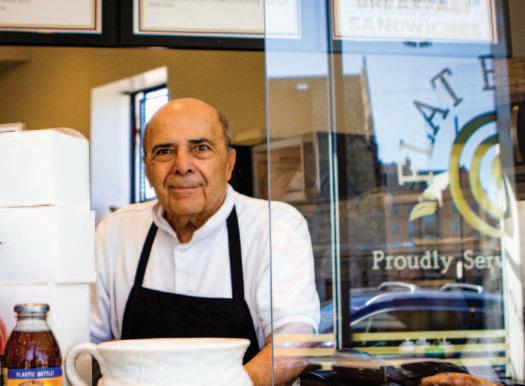
Many BC students who have passed through campus in the past 30 years are familiar with Acampora, who has given them
foundation.”
Acampora’s Catholic faith has always been central to his identity, he said. After spending his formative years at St. Margaret of Cortona Church, a Catholic parish, Acampora received a Jesuit education at Fordham Preparatory School and later at Fordham University, where he studied business.
After his graduation from Fordham University, Acampora had no plans of entering the food service industry, he said.
Acampora’s long and winding career path began with him rejecting the opportunity to work on Wall Street after college, and instead choosing to work in the hotel business. After six months of working at the front desk of the New York Hilton Midtown, which had just opened at the time he started working there, Acampora was asked to attend Hilton’s executive training program in Chicago, he said. From there, Acampora worked in cities all over the United States in
for me.”
After 27 years in the hotel industry, Acampora’s career path took a sharp turn.
When his son got into a serious car accident on his way home from college, Acampora embarked upon a six-year journey of supporting his son through 15 major surgeries.
“Through that six-year period, I left my job,” Acampora said. “There was really no reason for me to work—it was important that I be with my family and tend to my son’s needs on a day-to-day basis.”
When Acampora eventually returned to the workforce, he ventured into new territory, and Flat Breads Cafe was born.
“I was back to square one,” Acampora said. “But I saw BC as an opportunity. That nice little shop was open, and we took it over.”
Getting Flat Breads up and running was pretty simple—a “no-brainer,” he said. After renovating the space and putting a functional operating system into place, Flat Breads was open in three months. While the business has been modified over the years, Acampora said that it still exists in its original mold almost 30 years later.
“Flat Breads is not just a sandwich business,” Acampora said. “For me, it’s a way of life. It has given me the distinct opportunity to give back.”
His drive to give back has not gone unnoticed.
“Every time I go into Flat Breads, it’s a conversation with John,” John DeAngelis, a fellow Fordham Prep alum and CSOM ’23, said. “We always talk about Fordham Prep, and once the pandemic dies down, John wants to take us Fordham Prep guys out to dinner. He’s just a very kind man.”
DeAngelis is a Flat Breads regular, eating there about once a week, he said.
Breads—along with a sandwich. Acampora eventually ended up paying Charlie’s $90 weekly rent, he said, for which Charlie was grateful.
ora said. “There were even people who had graduated from BC 10 and 12 years ago that chimed in.”
Acampora had never realized the impact
more than just a hearty meal by striking up conversations, forming relationships, and providing care for the community.
Acampora said he attributes much of who he is to his upbringing in the Riverdale section of the Bronx.
“The Bronx has always been home base for me for a myriad of reasons,” Acampora said. “I was born into a loving and supportive Italian-American family, which is something that I look back on with pride. It’s the ground point of my personal and religious
a managerial capacity, eventually becoming the youngest corporate vice president for Hilton.
Acampora’s achievements were not overlooked—Sheraton soon made him an irrefutable offer to work in Boston, he said. With his wife and four children, Acampora moved to Weston, Mass. to pursue the opportunity.
“It was my dream job,” Acampora said. “I brought a sense of order to chaos at Sheraton, which was a really great opportunity
Beyond his relationships with BC students—whom Acampora said he looks at as if they’re his own children—Acampora has gone out of his way to support the underprivileged community of the greater Boston area.
Years ago, Acampora and his wife befriended a man in and out of homelessness named Charlie, who sold newspapers at the Church of St. Ignatius of Loyola on campus every Sunday. At the end of the day every Sunday, Charlie would exchange the change that he had earned for paper bills at Flat
More than a decade later, in 2020, Acampora befriended a homeless woman named Lauren. He encouraged Lauren to move off the streets and into a shelter downtown, giving her a $20 bill each time she left Flat Breads. Recently, Acampora discovered that, because of his support, Lauren was able to travel and return to her family in Iowa.
“As an 80-year-old man, I feel eminently fulfilled in that I’m living my Catholic mission in that shop,” Acampora said. “I’m living the traditions of St. Ignatius there.”
Like many other small businesses, Flat Breads closed for six months at the onset of COVID-19. Not only did the absence of students significantly decrease spring walkin customers, but also Flat Breads’ catering business ceased because of the pandemic, Acampora said.
“We needed to take drastic action, and we closed in early 2020,” Acampora said. “What rainy day funds we had were quickly absorbed, and we had to let people go. It was difficult.”
Around that time, Acampora organized a GoFundMe page, asking for the support of the BC and broader Newton communities.
The outpouring of support, Acampora said, was humbling.
“A collection of local people, and mostly students, chimed in to help us out,” Acamp-
that Flat Breads has had on its customers, he said.
“BC has a lot of staple restaurants, and Flat Breads is definitely one of them,” DeAngelis said. “It’s a homey environment, and it’s a nice place to be when you’re studying away from home.”
Paige Nixon, MCAS ’24, visited Flat Breads for the first time on her first BC “game day.” Although game days looked different during the COVID-19 pandemic, because spectators were not permitted in Alumni Stadium, Flat Breads remained a popular Saturday spot for students.
“The first time I went to Flat Breads, it was the first football game of 2020,” Nixon said. “There were tons of people picking up orders, and since we couldn’t attend the game or do anything associated with it, I thought it was really meaningful that all of the BC students went to Flat Breads to get their food for the game.”
Acampora said that Flat Breads received over 1,100 calls, emails, and cards in early 2020, saying that they missed it and asking when it would reopen.
“Therein lies the phenomenon of Flat Breads—people feel that they own a piece of us and that we serve our customers in the best of all traditions,” Acampora said. “I think that sustains us.”
Epstein’s Realistic Forecasts Retain Loyal Audience
By Eleanor Crowley Heights Staff
For many students, planning postgraduate life can be a difficult time. They experience a variety of emotions—some are unsure about their future careers and have not figured out exactly where they want to take their lives. This struggle, however, was not borne by Dave Epstein when he graduated from Colby College in 1986.
“I knew what I wanted to do,” Epstein, who completed Lynch and CSOM graduate programs in ’94 and ’01, respectively, said. “I knew I wanted to be in meteorology and specifically on TV.”
Epstein is a meteorologist and horticulturist who contributes to a variety of news sources, including The Boston Globe, WBZ, WBUR, CBS, and Boston. com, among others.
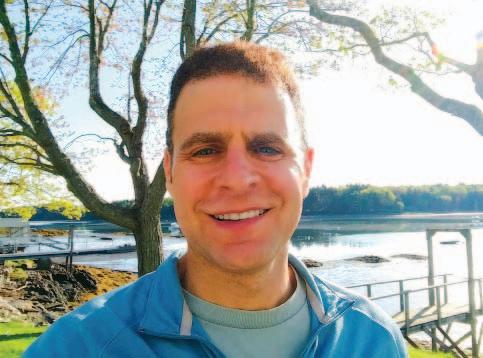
Though Epstein has achieved his career aspirations, his path had a rocky start.
“I didn’t have a job when I graduated in May,” Epstein said. “I had done internships and sort of done everything you’re supposed to do, you know, gotten internships, had a resume tape, but I just didn’t get hired. So it was a little frustrating.”
Struggling to break into the field of meteorology and forecasting, Epstein turned to teaching instead. His first year out of college, he taught as a substitute teacher and worked at an overnight camp during the summer. The next year, his substitute teaching gig became a full-time job as an eighth-grade science teacher.
“Though sort of unexpected, it was great and ended up being a wonderful experience,” he said. “I didn’t expect that I would be an eighth-grade science teacher, and I just absolutely loved it.”
The following summer, Epstein finally got a job working in television, which launched his career.
“I think that the theme was to be patient and not to get frustrated,” Epstein said. “I didn’t have the exact job I wanted, and things didn’t work out as I thought, but as long as I kept pursuing what I wanted, even if it didn’t happen on the
timetable I wanted, that was still okay.”
Epstein’s time teaching helped him uncover an interest in working with other people, he said. In 1992, he enrolled at Boston College to pursue a master’s in counseling psychology in the Lynch School. After receiving his master’s, Epstein has been teaching meteorology at Colby College for 15 years.
“Working with the 18 to 22-year-old population is really wonderful, and I think certainly having a master’s degree in counseling has helped me be a better educator as well,” Epstein said.
Four years after receiving his master’s degree, Epstein returned to BC to pursue his M.B.A., which he completed in 2001.
“I have my own business that I run, and the M.B.A. definitely helped that understanding of business and how to create a business and run it,” Epstein said.
While pursuing his M.B.A. at BC, Epstein was part of a program called Leadership for Change, which was offered jointly by the Carroll School of Management and the department of sociology in the Morrissey College of Arts and Sciences. During his time in Leadership for Change, Epstein met Eve Spangler, a professor in the sociology department with whom he formed a close relationship.
“[Epstein is] just wonderful to work with,” Spangler said. “He’s just really a wonderful multi-talented human being, and he’s just a lovely person to be friends with.”
Although the program has since been terminated, Spangler and the rest of the members of Epstein’s Leadership for Change small group have stayed in contact over the years and still meet a few times each year to reminisce.
“We just kept meeting for the fun of it as friends for 10 years now,” Spangler said. “We have dinner three, four times a year usually. He has the most amazing garden. He’s an incredible gardener. So we meet at his house and we walk around the garden together and catch up.”
Epstein’s diverse background—ranging from a master’s degree in counseling to an M.B.A.—has resulted in a wide
variety of careers. Though not exactly a traditional path, Epstein said he enjoys the variability that comes with having different jobs.
“One of the decisions I made at a pretty young age was that I didn’t want to work in a nine to five, or, in today’s world, sort of a seven to six job market,” Epstein said. “What I really like is the variety of things that I might do on a given day.”
Epstein said that any day for him may consist of writing an article for The Boston Globe, being on TV or the radio, speaking at a school, or just spending time in his garden.
Since 2006, Epstein has combined his passions for gardening and weather through his business Growing Wisdom, where he shares insight and offers video services to gardening and landscaping professionals.
Though many people worry about the finances of supporting oneself without a traditional nine-to-five job, Epstein said he has learned how to successfully support himself with multiple forms of income and said he sees his moderate financial success as a trade-off for the freedom that his career gives him.
Epstein said he believes that freedom and financial success are a trade-off—if you have immense financial success, the freedom of your time is limited as a result. Epstein does not measure success by a monetary value, he said, but rather by the amount of time he can spend doing what he loves.
Even though Epstein lost his fulltime job at WBUR at the start of the pandemic, he said he was lucky for having other sources of income and a spouse to support him.
“[The pandemic] has impacted things, but it hasn’t impacted things in the same way that many people were impacted,” Epstein said. “I still consider myself very fortunate in that I still have some income coming in.”
Epstein’s career as a meteorologist at WBUR may be over, but he said he feels his popularity among the people of Boston has not changed. He attributes Boston residents’ trust of him and his forecasts to his ability to prevent stress
about the weather.
An example of Epstein preventing people from stressing about weather, he said, is a typical New England twofoot snowstorm. People have to take the time to shovel out their driveways and are maybe late for work, but the inconvenience of the snow is usually relieved by the next day.
“I think one of the things I strive for is to be low-hype when it comes to the
that our wardrobe hasn’t necessarily changed, but when we take things out might change a little.”
While New Englanders basked in the warm weather and sunshine during what is usually a gray and dismal month, there is no need to panic about March having been unusually warm, according to Epstein. Instead, he suggests that people look at long-term trends to see the true effects of climate change.
weather,” Epstein said. “There are actually very few weather days which are really life-changing, and for most people, the most severe weather doesn’t happen.”
Part of Epstein’s personal mission has been to dissuade people from panicking about events like snowstorms, he said. Epstein also includes this mission to prevent panic in his views on one of the most recent and significant concerns pertaining to the weather—climate change.
Given the recent frequency of 70 degree days in Boston in March, it may seem like climate change is drastically affecting the daily weather, he said, but Epstein said that this is not the case.
“The way I like to phrase this for my students is, ‘Climate is the wardrobe you have in your closet, whether or not it’s what you’re taking out [to wear] for the day,’” Epstein said. “And so I still think
“In the next 20 or 30 years, it will be a different climate, per se, so you may have more clothing for warm weather than cool weather,” Epstein said. “But in terms of day-to-day, it doesn’t really impact it because weather is just what’s happening in the day-to-day, it’s sort of in the background.”
Through his Twitter account @growingwisdom, which has over 44,400 followers at the time of publication, Epstein has been able to connect with locals. He favors Twitter because of the ability to connect with everyday people, he said.
“You get an insight into how most people in the area lead their daily lives and that’s what keeps me grounded, is just to listen to them, rather than get caught up in the ‘Oh you’re on TV or on the radio,’” Epstein said. “It isn’t a big deal you know, it’s just a job at the end of the day.”
THE HEIGHTS
Flat Breads Cafe Serves Sandwiches and Jesuit Values
Epstein accomplished his childhood goal of becoming a meterologist.
MONDAY, APRIL 12, 2021 A5
PHOTO BY SARAH WEST / FOR THE HEIGHTS Acampora has owned Flat Breads Cafe for almost 30 years.
PHOTO COURTESY OF DAVE EPSTEIN
PHOTO BY SARAH WEST / FOR THE HEIGHTS
Acampora and his employees serve hungry BC students daily.
Epstein achieved his long-term goal of working in meteorology.
Boston College Should Mandate COVID-19 Vaccine for Fall Semester
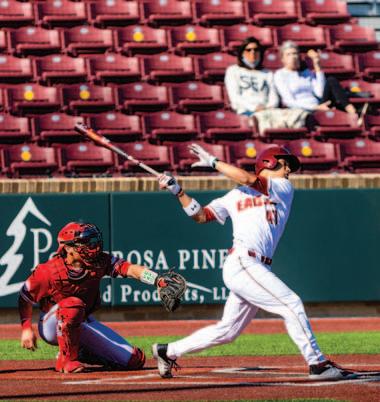

Boston College should require students to be vaccinated for COVID-19 in order to return to campus in the fall. If the University does not require the vaccine, students should get the vaccine anyway, in order to do their part in promoting the health and safety of the BC community.

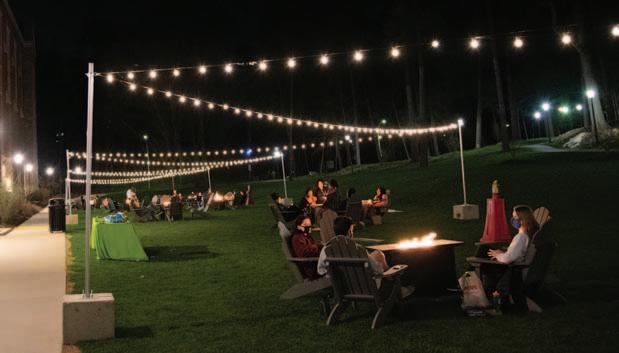
The University has required students to report for asymptomatic surveillance testing all year, so requiring vaccination next year would be a logical next step for the University.
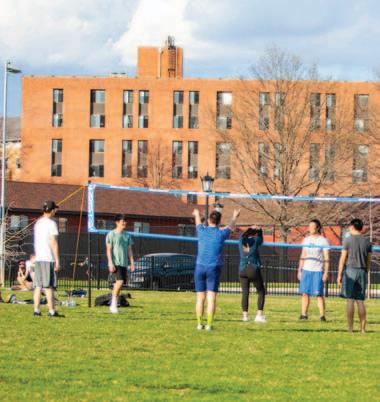

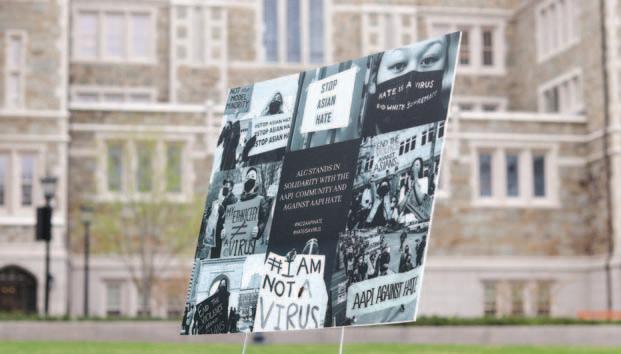
Several colleges have already announced that they will require students to receive the COVID-19 vaccine, including Northeastern University, which announced on April 6 that it will require students to provide proof of inoculation in order to return to any of its campuses worldwide in the fall. Boston University also announced on Friday that it will require students to be vaccinated in the fall, and will help students get vaccinated upon their return to campus if they are unable to get vaccinated over the summer.
Requiring students to get vaccinated will likely become a tricky legal and political issue. Governor Ron DeSantis of Florida banned “vaccine passports” in response to Nova Southeastern University’s announcement that it will require all students, faculty, and staff to be vaccinated against COVID-19 in order to return to campus in the fall. Massachusetts Governor Charlie Baker said on April 7 that he will not be instituting vaccine passports, as he wants the state to focus on getting people vaccinated. People who argue against requiring proof of inoculation say that it
is an issue of patient privacy. This argument does not hold in education, though, as schools already require students to provide proof of vaccination against other viruses in order to enroll. The difference with the COVID-19 vaccine is that it has received emergency use authorization rather than full FDA approval. This does not mean that the vaccine is any less effective, it means that people were able to receive the vaccine sooner after the clinical trials were finished.
BC requires students to submit proof of inoculation against tetanus, diphtheria, pertussis, hepatitis B, measles, mumps, rubella, varicella, and meningitis.
Massachusetts required all students to receive the flu vaccine in 2020 in an attempt to lessen the burden on the health care system. The deadline to receive the flu vaccine was extended from Dec. 31, 2020 to Feb. 2021. The mandate was dropped in January after the Massachusetts Department of Public Health determined that it was a mild flu season, so students were never actually required to provide proof of vaccination. While many students did not end up needing to provide documentation, the mandate likely prompted more students to get the flu shot than usual.
With the COVID-19 vaccine becoming more widely available, BC should require students to be vaccinated to return to campus in the fall. University Health Services currently has the COVID-19 vaccine listed as “highly recommended,” but the University should follow the lead of Northeastern, BU, and the growing list of other colleges, and make vaccination a requirement,
not just a recommendation.

The University should also follow the example of BU and assist students in getting vaccinated in the fall if they are unable to before the start of the fall semester. Further, if the University has the ability to provide the vaccine to students this semester, it should opt for the one-dose Johnson & Johnson vaccine. This would help ease the burden of getting vaccinated for students who are residents of states where COVID-19 vaccines are not widely available. Holding a vaccination clinic of the one-dose vaccine before the end of this semester would eliminate the problem of students getting their first dose of a two-dose vaccine in Massachusetts, and then struggling to get their second dose in a state where the vaccine is not as widely available.
All people ages 16 and older who live, work, or study in Massachusetts will be eligible to get the vaccine on April 19 and can pre-register for an appointment now. At the moment, appointments are still limited, but there are some helpful resources for students who do want to get vaccinated in Massachusetts. The Boston Globe and Boston Magazine both have helpful guides on how to navigate the process of getting a vaccination appointment. There is also a bot on Twitter (@vaccinetime) to help find open vaccination appointments in Massachusetts.

Regardless of whether or not BC ends up requiring the vaccine, students should put the needs of the greater community ahead of any personal reservations they have and get the vaccine.
Week in Photos

THE HEIGHTS A6 MONDAY, APRIL 12, 2021 EDITORIAL
Top photos, left to right: Students gather at BC After Dark—a bar and restaurant on campus, Saturday, April 10; Students sit around fire pits at a new on-campus hangout spot called Baldwin’s Backyard, Saturday, April 10; The AHANA+ Leadership Council (ALC) tabled on the quad to get signatures to pledge solidarity with the Asian, Asian American, and Pacific Islander communities, Wednesday, April 7.
Bottom photos, left to right: Freshman outfielder Cameron Leary bats against NC State, Friday, April 9; Junior catcher Gianna Boccagno slides to home base but is tagged out by Syracuse sophomore catcher Maxine Barnes, Saturday, April 10; BC students enjoy the warm weather and play volleyball on Maloney Lawn, Saturday, April 10; Sophomore Melissa Mao played a set of three songs with two original songs, Saturday, April 10.
(NICOLE VAGRA / FOR THE HEIGHTS); (ANEESA WERMERS / HEIGHTS STAFF); (JESS RIVILIS / HEIGHTS SENIOR STAFF); (IKRAM ALI / HEIGHTS EDITOR).
A Message To Prospective Students: BC Is Still Homophobic

“As a private university, Boston College’s decisions regarding investments and governance are made by University leadership, in concert with the Board of Trustees,” a University statement at the time read.

Contrast this with Associate Vice President for University Communications Jack Dunn’s defense of BC’s cancellation of the GLBTQ+ Leadership Council Ball in 2005.
pay. (Side note: If you were offended by his music video, I would reconsider calling yourself an LGBTQ+ ally). In light of BC’s institutional homophobia, Lil Nas X has more moral authority than Leahy ever will.
With the approaching May 1 deadline for high school seniors to decide whether or not to accept an offer of admission to Boston College, some students may find themselves wondering what navigating college life at a Catholic institution might be like. After nearly four years attending BC as an LGBTQ+ student, I feel it is my obligation to inform prospective students that, in 2021, BC remains a deeply homophobic institution.
Recent events—both at BC and in the world at large—have shown that BC is an institution living in the past, adhering to outdated, offensive conceptions about members of the LGBTQ+ community that are not acceptable at a top-tier institution of higher education.
The Vatican announced in a statement on March 15 that it will not bless the right of people to marry people of the same sex. The statement doubled down on the church’s position that homosexual activity is sinful, referred to gay people as “persons with homosexual inclinations,” and reiterated a previous statement that “there are absolutely no grounds for considering homosexual unions to be in any way similar or even remotely analogous to God’s plan for marriage and family.”
When faced with the choice to stand with its marginalized students, the BC administration chose to stay silent. BC’s silence on important issues of social justice, particularly when the issue is tangential to BC or its Catholic background, is something with which incoming students will soon become intimately familiar.


BC’s silence today is just another item on a long list of hypocrisies. To those who would claim that BC can’t go against the Vatican, I would direct you to when BC did exactly that last June. The Vatican called on Catholics to divest from fossil fuels, to which BC responded, in essence, that it can do whatever it wants.
“As a Catholic university, we cannot sanction an event that promotes a lifestyle that is in conflict with church teaching,” Dunn said in a University statement.
If you would like to consider other anti-LGBTQ+ institutional practices at BC, I would point you to the fact that BC still refuses to establish an LGBTQ+ resource center and does not hire as many full-time employees that deal solely with LGBTQ+ students (as opposed to full-time employees for students of color or students with disabilities).
In 2016, the University again argued that BC has to maintain tenets of its Christian faith, that a resource center wouldn’t be a panacea for LGBTQ+ issues on campus, and that administrators don’t really see any tension around sexual orientation at BC.
“From our perspective, there has always been a loving, welcoming, fully embracing relationship with our LGBTQ students,” the University said. “The tensions are often perceived on the student end more than they are on the administrative end.”
And thus BC has developed an institutional policy: Ignore the Vatican when it’s profitable, ignore LGBTQ+ students when it’s convenient, and pay no mind to issues of social justice.
In 2017, when incidents of on-campus racism rocked the BC community, thousands of students gathered to proclaim that “Silence is Still Violence.” Notably, University President Rev. William P. Leahy, S.J., was silent. Leahy’s silence then, and the administration’s silence now, make BC complicit in the discrimination that still pervades society today.

Lil Nas X, the gay rapper of “Old Town Road” notoriety, recently released a music video where he pole dances his way into hell, signaling that if hell is the price to pay for being unapologetically gay, it’s a price he will gladly
The administration’s silence permits and cultivates an atmosphere of homophobia on campus. This ranges from occasional incidents of explicit homophobia and transphobia—looking at you, College Republicans—to smaller, everyday acts of discrimination with which every member of the LGBTQ+ community is intimately familiar.
On March 29, BC College Republicans hosted notorious homophobe and transphobe Hadley Arkes, who gave a lecture that promoted conversion therapy, argued that homosexuality is a choice, and compared homosexuality to drug use and prostitution. At this point, after hosting a white supremacist last year, BC College Republicans should be considered a hate group and not an officially sanctioned student organization with University funding.
Take this into consideration for a moment: BC funds a group that invited someone preaching about conversion therapy, and yet can’t be bothered to fund an LGBTQ+ resource center or hire sufficient fulltime staff dedicated solely to working with LGBTQ+ students.
Now, I want to make clear that I treasure my experience at BC. I have received a phenomenal education, made lifelong friends, and dealt with administrators who truly do want to make me feel welcome on campus. Even so, I wish someone had told me what it’s like to be LGBTQ+ at BC.
I’m sure BC is not the only college where I would be called “f****t” in the freshman lounges or overhear passing comments like “that’s so gay.” Homophobia is ever-present across all echelons of society in the United States. But the BC administration’s silence and even active antagonization of the LGBTQ+ community makes BC a uniquely homophobic university.
Scott Baker is an op-ed columnist for The Heights. He can be reached at scott.baker@bc.edu.

Families on Campus
Seeing families on campus together is a wholesome reminder of home. Seeing high school students awkwardly take photos in front of Gasson is a throwback to college-visiting days and normalcy. Attending classes and being comfortable on campus is a part of Boston College students’ everyday lives, but every current student was once a prospective student, and it’s a huge thumbs up to see others appreciate BC too.
To Deliver Results, the Filibuster Must Go
SOPHIE CARTER
When Americans head to the polls in November of 2022 to cast their votes in the midterm elections, they will surely be pondering a wide range of issues: How did the Democratic Party, upon recently gaining control of the legislative and executive branches, help put food on the table during COVID-19? How did it work to protect workers’ rights? How did it lower the burden that accessing affordable health care places on working families?
When working people go to the polls next year, they will be voting based on whether they see tangible results from the government that promised to work on their behalf. They will not be voting based on their opinions on the Senate cloture rule, an obscure piece of Senate procedure that is left over from the Jim Crow era. That’s why it’s long overdue for the Senate to abolish the filibuster.



The cloture rule is a piece of Senate procedure that requires sixty votes to end a filibuster on a piece of legislation and bring it to a final vote. The filibuster was popularized by segregationist senators to block civil rights legislation. In fact, the longest “talking” filibuster on record was delivered by Senator Strom Thurmond in 1957 as a means of blocking an early version of the Civil Rights Act. To this day, it persists as a mechanism by which a minority of senators can obstruct any piece of legislation that comes to the floor.

Contrary to popular belief, filibusters do not have
to involve one person standing up and speaking for hours on end. All the rule requires to keep a bill from moving to a vote is for forty-one senators to vote “no” on invoking cloture. With Republicans currently holding fifty seats in the Senate, it is nearly impossible for Democrats to overcome the filibuster and move to a vote on any of their agenda items. Republicans’ ability to refuse to invoke cloture has the power to effectively kill any bill that would otherwise pass democratically with a simple majority when actually brought to a floor vote.
In the past several months since President Joe Biden took office, the filibuster has been weaponized to block legislation that would strengthen voting rights and election security, raise the minimum wage to a living wage, make it easier for workers to join unions without the fear of employer retaliation, and allow for a pathway to citizenship for the millions of undocumented people in America. Due to the filibuster, it is highly unlikely that many of the large agenda items promised by President Biden during the presidential election will come to fruition once they reach the Senate. It’s become clear that Republicans aren’t likely to compromise.
One frequent objection to the removal of the filibuster is its potential to backfire once the shoe is on the other foot and the Republican Party is back in power. Mitch McConnell, the Senate minority leader, recently threatened a “scorched earth” approach to governing if the filibuster is removed. Many Democratic lawmakers are reluctant to abolish the filibuster because the memory of Republicans’ employing the nuclear option to confirm conservative Justices Neil Gorsuch, Brett Kavanaugh, and Amy Coney Barrett by simple majority is still painfully fresh.
This all or nothing approach is not the point. The United States Senate itself, with its two senators per state makeup, is deeply undemocratic in that it gives disproportionate power to sparsely populated, rural,
white, Republican states. Not only does the filibuster add exponentially to the undemocratic nature of the Senate by allowing a minority of senators to obstruct any possible action, it also leads to gridlock for even the most pragmatic of actions. In order for the Senate to be able to continue calling itself “the greatest deliberative body in the world,” those in power need to make it possible for the Senate to actually do something.
In order for the Democratic majority to end a filibuster on a bill in the current Senate, it has to face the insurmountable task of convincing ten Republican senators to defect from the orders of “Grim Reaper” McConnell. Neither party is able to pass any legislation on their respective agendas, and this has led to a stalemate that manifests itself as a striking inability to address crises as they pop up, such as the COVID-19 pandemic. As a case in point, the only reason the most recent stimulus bill made it through the Senate is because it was not subject to the filibuster. Other crises that directly impact working people, such as Amazon’s retaliation against workers fighting for safe working conditions, will never see a solution passed through the Senate.
Biden won the presidency on a promise to tackle the various hardships facing everyday people in this country. Abolishing the filibuster is the first step necessary to fulfilling these promises. It has become clear that Democrats can’t control whether or not Senate Republicans will choose to stop obstructing all options for positive change. The only thing they can control is how they choose to respond to this obstruction. It’s past time for Democrats to abolish the filibuster and fight to enact real change for working people.
Sophie Carter is an op-ed columnist for The Heights. She can be reached at sophia.carter@bc.edu.
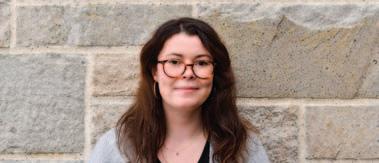
The opinions and commentaries of the op-ed columnists appearing on this page represent the views of the authors of those particular pieces, and not necessarily the views of The Heights
Impeccable Landscaping
With the arrival of spring and college visits, BC is once again on a mission to perfect its landscaping. The trees are blooming, flowers are sprouting, the grass is bright green, and mulch is the icing on the cake.
Talking in Bapst
Bapst is a silent library. But, there seems to be a growing phenomenon of students simply forgetting this fact of life. The occasional flashback-inducing alarm or Bluetooth connection mishap is par for the course, and the silence soon resumes like a warm blanket. But taking interviews, Zooms, or discussing homework—even quietly—is outright embarrassing. If the activities listed above are absolutely necessary, BC has the perfect spot: O’Neill!
Million Dollar Stairs
The Million Dollar Stairs are both a beloved staple of BC’s campus and an unsympathetic test of one’s lung capacity. This stairway to heaven conjures up unique challenges during each season. In the winter the stairs are an icy test of fate. But, in the spring and summer, the heat and pollen combo induces flashbacks to middle school pacer tests, and the masks certainly don’t help.
THE HEIGHTS
MONDAY, APRIL 12, 2021 A7
SCOTT BAKER
GRAPHIC BY MEEGAN MINAHAN AND OLIVIA CHARBONNEAU / HEIGHTS EDITORS
TlkiiBt
By Alexandra Morin Heights Staff
Eating a balanced diet has always been of great importance to me. While I absolutely love to indulge in more decadent meals on the weekend, during the week, I try to stick to a high-protein diet while also incorporating a variety of healthy fats and vegetables.
This carne asada bowl has been one of my go-tos for quite some time. With mouthwatering steak, hearty black beans, rich avocado, and flavorful rice, this bowl is not only nourishing but also incredibly satisfying.

While it may be tempting to order something like Chipotle on Doordash or Uber Eats, the freshness and flavor profile of creating this bowl yourself is unmatched. Additionally, using your own ingredients allows customization to your specific flavor palette.
With the weather getting warmer and summer on the horizon, now is a great time to whip up this fresh and filling dinner.
RECIPE:
For the steak:
Start out by mixing together the soy sauce, cilantro, lime juice, olive oil, garlic, jalapeno, orange juice, cumin, and salt and pepper.
Reserve half of this mixture in the fridge to pour over the top of the steak at the end of your cooking process.
Place your remaining marinade and your flank steak in a Ziploc bag and massage the meat with the mixture. Place the bag in your fridge for four to six hours, occasionally flipping the meat around to make sure it is evenly coated.
After letting the meat sit, remove it from the Ziploc bag, disposing of the excess marinade that has not seeped into the meat.
Using a cast iron skillet on medium high heat, place the flank steak in the pan and allow it to cook for around four to five minutes on each side for medium rare.
After you have reached your desired doneness, let the steak rest for five minutes before slicing it against the grain.
Pour the reserved marinade over the top before placing your carne asada in a serving bowl.

For the beans:
Pour out the contents of one or two cans of black beans.
Mix in the garlic powder and chili powder along with the desired amount of salt and pepper.
Allow flavors to meld together and cook thoroughly on a low heat for around 20 minutes.
For the cilantro lime rice:

Follow the directions on your bag of long grain rice for rinsing the rice, adding the right amount of water to your desired number of cups of rice, and for cooking time. In general, the ratio is usually 1 cup of rice = 2 cups of water.
Once the rice is fully cooked through, fluff the rice with a fork.
Lastly, squeeze the limes into the rice and fold in the chopped cilantro.
For the pico de gallo Finely dice tomatoes and white onion.
Next, mix in the lime juice and
cilantro
Serving:
rice,
“i’m yours” Shows Appreciation for Observing Art in Person
By Elinor Ketelhohn Heights Staff
On display at the Institute of Contemporary Art Boston (ICA), i’m y ours: Encounters with Art in Our Times addresses the new role of art and art museums in people’s lives as they adjust to the changes brought on by the COVID-19 pandemic.
The museum, which reopened in March after being closed for months, especially recognizes the importance of art and connection. This exhibit invites visitors to establish connections to art that highlight the themes of home and history, social injustice, material transformation, and identity that emerged this past year, according to the ICA website.
The exhibit takes its name from a painting by Henry Taylor already in its collection, symbolizing the ICA’s belief that without visitors, the museum is incomplete. The pandemic has made the in-person experience of art all the more impactful.
The ICA curated the exhibit amid the pandemic and Black Lives Matter protests this summer to reflect on the
lockdown and social unrest, according to the ICA website. The selected works address themes of isolation, home, and history.
Some of the works directly reflect the pandemic and political movements, while others allude to the various struggles faced during the tumultuous time.
The pieces are divided by theme into various sections within the exhibit: “Home Again,” “Opening Act,” “Unbound,” “What Remains,” “In Material,” “Looking Out,” and “Closing Act.”
“Home Again” explores the role of a home in someone’s life, as it has been redefined by the COVID-19 pandemic. The function of a home has changed from a place of relaxation and comfort, to serving as an office, school, and a place of confinement and loss, according to a plaque at the museum.
One of the photographs from this section is “Orly and Ruth” (2020) by Rania Matar from the series Across the Window: Portraits During COVID-19 The work depicts a girl hugging her sister, separated from the photogra-
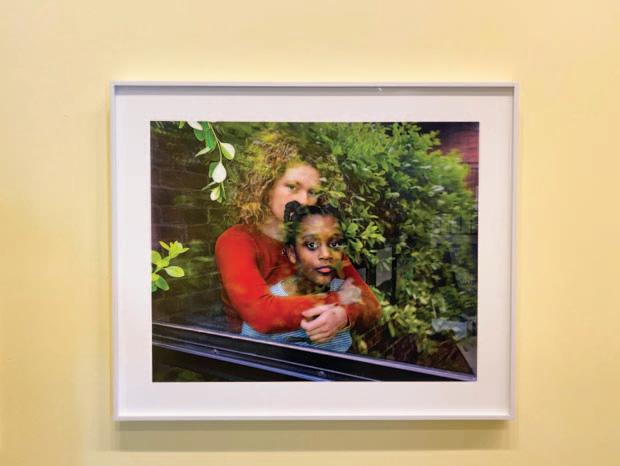
pher by a window, and embodies the themes of home and separation.
This piece illustrates how family ties and relationships have been sustained within the home during the pandemic. Within the photograph, the reflective surface of the glass window, displaying both the girls inside the house and the world outside, shows how connection remains possible even during a time of isolation.
Although relationships with the outside world are difficult to maintain during the pandemic, this piece shows how connections within a household grow stronger during confinement and isolation.
“It is difficult for many families and friends to see each other during the pandemic,” attendee Maria Delgadillo, from Houston, Texas, said. “I love that this photograph is hopeful.”
In the “In Material” section, “Objectification Process” (1989) by Cady Noland is composed of metal, plastic, and fabric. Noland placed a rolled American flag in a plastic case across an orthopedic walker with attached chains.
The piece symbolizes restriction of progress and movement, in order to question how politics influences social life, according to a plaque at the exhibit.
“It is relevant today, even though it was made 30 years ago,” Delgadillo said. “The chains imply that the country is somewhat confined, or maybe to the oppression that many Americans face.”
The sculpture “Hanging Fire (Suspected Arson)” is hung at the center of the “What Remains” section. The artist, Cornelia Parker, created the piece using the remnants of a burnt residence, according to the ICA website.
The sculpture is constructed using the pieces of charred wood from a real case of suspected arson. The pieces are then strung together to form a geometric, hanging sculpture.

“[‘Hanging Fire’] was my favorite piece,” Delgadillo said. “It’s different from the other pieces because of its unique medium and shape. It actually looks like it’s falling because some pieces are almost on the floor, so everything looks scattered.”
This piece is intended to represent destruction and resurrection, referencing humanity’s mutability and vulnerability while tackling challenges in life, according to a plaque displayed at the museum.
The sculpture is meant to address the intense emotions shared throughout the period of extreme loss.
“The black shards represent our time now,” museumgoer William
Sweet of Brooklyn, N.Y., said. “They show how our lives have been fractured because of COVID-19. Now it’s our job to build ourselves back up.”
The exhibit will be on display at the ICA until May 23. Virtual tours of this exhibit are also available online.
Highlighting themes that hit close to home during the pandemic, the emotional relatability of the exhibit resonates with museumgoers.
“Pain and loss were constant themes [throughout the exhibit]. I feel that many pieces reflect the human lives lost because of COVID,” Sweet said. “Deaths were more than just a statistic. They were shown in a personal and real way.”
THE HEIGHTS
DISH: Carne Asada Bowl (with cilantro lime rice, mild pico de gallo, and black beans. Yields 4 bowls.
The sculpture “Hanging Fire” utilizes the remanants of a burnt residence
and make sure to taste for needed salt.
Place desired amount of beans,
carne asada, and pico de gallo in your bowl. Scoop out one half of an avocado and a lime wedge to place in the bowl for freshness. Enjoy!
A8 MONDAY, APRIL 12, 2021
ELINOR KETELHOHN / HEIGHTS STAFF
Quarantine Kitchen: Carne Asada Bowl
ALEXANDRA MORIN / HEIGHTS STAFF
steak infuses it with fresh flavors.
PHOTO COURTESY OF ALEXANDRA MORIN / HEIGHTS STAFF Adding marinade to the
flank
Rice, beans, and steak are complemented by a bite of pico de gallo.
Cilantro, jalapeno, and orange juice produce a bright and fresh marinade
INGREDIENTS:
the steak/marinade 1- 1¼ lb flank steak ¼ cup soy sauce ½ cup cilantro leaves (plus more for garnish) 1 lime juiced ⅓ cup olive oil ½ an orange juiced 1 jalapeno finely diced 3 cloves of minced garlic 1 teaspoon cumin Salt and pepper to taste For the additional items in the bowl: (beans) 1½ - 2 cans of black beans Salt and pepper 2 tablespoons garlic powder 1 tablespoon chili powder (rice) 1½ - 2 cups
1 - 2
¼ cup
⅓ white
bit
½
Salt
Lime
ALEXANDRA MORIN / HEIGHTS STAFF
For
of long grain white rice
limes juiced
finely diced cilantro (mild pico)
onion One medium ripe tomato A
of finely diced cilantro
of a lime juiced
to taste (extras) 2 avocados (½ per bowl)
wedges
ELINOR KETELHOHN / HEIGHTS STAFF
The photograph “Orly and Ruth” portrays confinement during the pandemic.
Boston Docuseries Director D elves Into Art Theft
BY ALICIA KANG Asst. Arts Editor
What does 200 million dollars look like?
For the Isabella Stewart Gardner Museum in Boston, this massive sum takes the form of 13 works of art, which were stolen by two thieves three decades ago.
On March 18, 1990, a pair of men dressed as police officers entered the Isabella Stewart Gardner Museum after hours declaring they had received a complaint. Seemingly unaware of their true identities, night guard Richard Abath let them in, and what ensued became the greatest art heist

in American history—one whose culprits walked away without leaving behind a single lead.
Through Netflix’s latest docuseries, This Is a Robbery: The World’s Biggest Art Heist, director Colin Barnicle delves into what exactly happened on that fateful night and the numerous investigations and theories that bloomed from the yet-to-be-solved crime.
Having grown up in Boston, Barnicle has known about the robbery his entire life.
“It was one of these, you know, true whodunit mysteries in our hometown,” Barnicle said in an interview with The Heights.
To put the docuseries together, Barnicle
interviewed countless sources, from those who worked at the Gardner to those implicated in the investigation. When trying to find hard evidence on the heist, however, Barnicle encountered a lot of obstacles. None of the information from the 1990 investigation was digitized since no formal arrests related to the case were made, so Barnicle had to take a bit of an analog approach to conduct his research.
“Working around it meant like getting files from Norfolk County Courthouse,” Barnicle said. “And you can only go into a room and swipe through them for an hour.” After a few brief interviews with first-
hand witnesses, the first episode of the docuseries dives into what makes the museum so great in the first place—in other words, why should we care that a bunch of art was stolen?
Personal testimonies featured in the documentary detail how the museum seems to invoke a surreal love of art within everyone who visits it, and the various interviews Barnicle includes in this episode are enough to make viewers believe art can be transcendent.
Former guard Karen Sangregory said to this day she “still has dreams about the Gardner Museum.” After speaking about some of her favorite aspects of the building, namely its masterful architecture, the docuseries shifts to Sangregory recounting her arrival to work the morning the crime was discovered.
But, Barnicle does not focus only on those who loved working at the Gardner. His interviews profile people who, perhaps like some potential viewers of the series, felt somewhat indifferent toward the museum.
Abath, for example, was the night guard who let the robbers in. Though he worked at the Gardner, he wasn’t filled with the same passion Sangregory or Hawley carry into their interviews. His role in the historic heist actually led to an entire theory that the theft was an inside job, as he had been known at the time for disagreeing with the efficacy of the museum’s security policies.
Myles Connor, a known art thief from Boston, was another prime suspect at the time. Barnicle named Connor as one of his favorite people to interview because of all
his eccentricities.
The first episode only scrapes the surface of everything the docuseries encompasses. As more and more of the nitty gritty details are exposed, Barnicle dives into the heist’s connections to the Boston Mafia at the time. As the story picks up, the plotline becomes more complex, but so does Barnicle’s methods of telling it. By inserting timelines and other creative visuals to illuminate the actual facts of the heist as well as the many theories, Barnicle keeps the audience engaged and informed as the story gradually unfolds. When Barnicle describes the robbers’ route through the museum, for example, he uses a 3D model of the Gardner to show exactly which rooms the two thieves visited and where they were in relation to each other.
“We really want to be able to take people through it almost like an Agatha Christie novel,” Barnicle said. “You’re going through the investigation.”
Through beautiful, Steadicam shots of the exhibit and intense string music, Barnicle helps viewers understand the excitement of the heist and the passion the Gardner’s faculty must have for retrieving the stolen works, both three decades ago and today.
“There’s no verdict. There’s no evidentiary finding. There’s no arrest,” Barnicle said. “... So it’s like a black hole.”
Even without a solid verdict, This Is a Robbery brings the sensationalized art heist to life. The docuseries has something to excite every viewer, from fans of the mobster movie The Godfather to die-hard art buffs. Barnicle makes this black hole one worth jumping into.
Virtual Concert Series To Celebrate Grad Students
BY KATHERINE CANNIFF Assoc. Arts Editor
After a year of feeling disconnected from the Boston College campus, BC graduate students will come together for a three-part virtual concert series set to take place on April 16, 23, and 30. Each night, between 6 and 7 p.m., a local Boston-area musician will perform over Zoom, followed by a question and answer session. The musical guests include Jazzmyn RED, Cliff Notez, and Danny Rivera.
The event will be hosted by the Graduate Student Association (GSA), which is composed of representatives from the graduate colleges of BC, as a celebration of Graduate Student Appreciation Month. The organization has planned programming in the past to support the graduate student community—including fireside chats with industry professionals and a walk for racial justice.
For the music event, GSA has collaborated with Boston Art & Music Soul (BAMS) Fest to organize the concert series. BAMS Fest is a non-profit based in Dorchester, Mass. that, according to its mission statement, works to break down racial and social barriers in the arts and music communities, cultivating a diverse and inclusive community in the Greater Boston area.
BAMS Fest held its debut festival in June
2018 and since then has continued to grow. In past years, the annual summer event brought upwards of 8,500 attendees to its multiple stages spread throughout Franklin Park, which is in the Jamaica Plain, Roxbury,
The virtual format not only offers a safe way for graduate students to interact during the pandemic, but it also gives the audience a peek into each artist’s world. The musicians will be streaming from their homes or any
non-profit’s mission resonates with GSA’s mission to encourage diversity and address racism at BC. Morris selected the musicians that will be performing, and Hernandez said GSA is excited that the event will help

of challenges as a result of the pandemic. Without the dorm-living environment or shared dining spaces available to undergraduate students, graduate students have felt detached from the campus community, Hernandez said. Although the new class of graduate students had a virtual orientation, since many work remotely, it is difficult to connect with BC graduate peers.
But GSA is hoping the concert series, which can be accessed through MyBC on the Agora Portal, will give students an opportunity to relax and interact with each other over Zoom.
During the open discussions following the performances, attendees can chat while also engaging with artists from the Greater Boston community who incorporate messages of racial and social justice into their creative work.
and Dorchester neighborhoods of Boston.
But the 2021 outdoor festival has been postponed until the summer of 2022. Instead, the non-profit started a virtual speaker series called ARTDACITY in addition to creating the small-scale virtual concert series with GSA.

location of their choosing—reminiscent of NPR’s Tiny Desk (Home) Concert series.
Dewin Hernandez, director of GSA and a dual degree student in CGSOM and MSW ’21, had the idea for the event and contacted Catherine Morris, founder and executive director of BAMS Fest. Hernandez said the
“I think it is really important [to highlight] … those who are speaking to the issues that are most pressing today and are using their music and their art as a means to start the conversation,” Hernandez said.
Graduate students have faced a plethora
“It’s so hard over your computer to feel part of Boston College, so I think it’s really exciting that you can tune in, chat with your peers, connect with Boston artists, [and] get a sense of where you are,” Marina Rakhilin, intern of communications and graduate assistant at the Office of Graduate Student Life and MSW ’23, said. “It’s so grounding and it’s so exciting, and these are people talking to issues of racism and isolation—everything that everyone is going through. And I think that art is the best way to do that.”
BC Solo Singers and Bands Shine at Quadstock Concert
B Y E RIN P ENDER Heights Staff
Taking a twist on the annual Modstock event, the Campus Activities Board and Boston College Music Guild brought together some of BC’s most talented musicians for an in-person performance called Quadstock— hosted on the grassy lawn outside of the O’Neill Library.
The beautiful weather was complemented by the sounds of live music coming from the O’Neill Quad on Saturday, where a stage was set up and socially distanced chairs were stationed for audience members.

The evening consisted of three acts, each featuring performances from BC student musicians who performed covers of songs and even original pieces.
Act One began with Melissa Mao, MCAS ’23, opening the show by inviting the audience to sing along with her on “Dayman Song” from the television series It’s Always Sunny in Philadelphia
She then lent her agile and indie voice to a cover of “Skinned Knees” by Soccer Mommy. Mao then sang two original songs, one of which she said she finished just before the show began.
Katelyn Ginley, MCAS ’23, covered “Electric Feel” by MGMT and “Toxic” by Britney Spears, adding a
cool acoustic flair and impressive riffs to these pop performances. Ginley also sang an original song filled with contemplative lyrics such as “I would walk to you if I knew the way / I would tell you if I knew what you wanted me to say.”
Following Ginley, Adrianne Goodfriend, MCAS ’23, brought life to her original songs, including her piece called “Into the Mystic,” with her jazztinged indie voice.
To close out Act One, Riley Aquilano, MCAS ’22, brought his impressive guitar skills to his three unnamed original songs, which also showcased his falsetto vocals. BC student bands Uncommonwealth and thefineprint. took the stage for Act Two.
Uncommonwealth featured five band members and sang six songs, including covers of “Movin’ Out (Anthony’s Song)” by Billy Joel and “Lonely Boy” by The Black Keys. The band finished out with its recent song “Phoenix from Mars,” which channels a cool alternative rock sound.
The next half hour set of Act Two was thefineprint., an alternative rock duo of two BC graduate students.
The duo’s performance incorporated pre-recorded segments of music played along with the live performance, creating a layered sound effect.
The band’s eight-song set showcased impressive drumming and
smooth vocals, and included its original song “(Don’t) Look My Way,” which was featured on the duo’s 2019 album Kites and Body Bags , and its latest single, “My Only Friend.” Although the single was released back in August, Quadstock was the duo’s first time performing it.
Sleepwalkers and Photo Negative closed out the show in Act Three. Sleepwalkers opened with a cover of “Come Together” by The Beatles and continued their set with their jazzy, light rock sound.
In particular, the harmonies among the vocalists flowed together nicely with the chill vibe of the songs.
Photo Negative’s set infused the quad with energy, with its alternative rock sound and outstanding saxophone, drums, guitar, and vocals.
The band’s set included its songs “NBN,” “Modset,” “2 AM,” and “Whatever Floats Your Boat,” as well as a cover of Cheap Trick’s “Surrender,” which ended by transitioning into a guitar solo of “Smells Like Teen Spirit” by Nirvana.
With students milling around th e O’Neill quad while taking in thes e live performances, they enjoyed th e sounds of live music coming fro m campus once again.
After being unable to perform i n live shows for so long because of the pandemic, it is clear the artists hav e not lost their talent for performin g and their ability to captivate audiences. After a long period of virtual performances, Quadstock enable d BC musicians a rare opportunity to perform for a live audience.
elevate local BIPOC artists.
A9 THE HEIGHTS MONDAY, APRIL 12, 2021
ALI / HEIGHTS
IKRAM
EDITOR
PHOTO COURTESY OF NETFLIX
GRAPHIC BY MEEGAN MINAHAN / HEIGHTS EDITOR
Director Colin Barnicle explores the history of the unsolved 1990 heist at the Isabella Stewart Gardner Museum.
Playing the piano, Sarah Costello, Lynch ’23, joined Adrianne Goodfriend, MCAS ’23, to perform an original song.
‘Thunder Force’ Flops With Cliche Humor
Superhero action movies hold a special place in many people’s hearts. They’re a guilty pleasure or an obsession that transports viewers to a world where the underdogs always triumph and justice is routinely served as the credits roll. They’re captivating with worlds of futuristic inventions and dignified heroes. But, when they flop, they really flop—and they can’t be saved by any number of sleek outfits, intense combat scenes, or cool cars.
Thunder Force, the latest installment in the superhero genre released April 9 on Netflix, doesn’t deliver a compelling science fiction story, and it completely misses the

mark as a comedy. The movie, directed by Ben Falcone, seemingly can’t decide if it is a parody of superhero films or if it wants to be taken seriously.
Set in Chicago, the movie takes place after a cosmic ray strikes Earth, triggering genetic mutations that give certain people, called Miscreants, superpowers. But, the only humans struck by the ray are those already predisposed to becoming sociopaths.
Within this world where Miscreants roam, the movie tells the story of best friends Emily Stanton (Octavia Spencer) and Lydia (Melissa McCarthy)—two outsiders brought together when Lydia defends Emily from a schoolyard bully. Emily is determined to avenge the death of her parents, who were killed by Miscreants, by becoming
a scientist and inventing a way to rid the world of Miscreants. But, Lydia falls behind her ambitious friend and they become estranged. When they finally reunite, Emily has successfully invented a treatment to bestow superpowers on anyone to be used for good to defeat the Miscreants, and Lydia accidentally becomes her first test subject.
Only a few minutes into the film, it becomes clear that Netflix made a mistake categorizing it as a comedy. Jokes fall flat as the film desperately tries to deliver some humor among the otherwise choppy dialogue. Lydia and her awkward friend, Clyde, debate the correct way to deliver a knockknock joke in one cringeworthy scene. The humor is steeped in clichés and relies on unoriginal punchlines—from scenes showing the characters walking into glass doors to awkwardly spilling a drink on someone you don’t know well.
Desperately trying to inject some humor into the science fiction tale, random cultural references are scattered throughout the movie. Emily’s daughter battles Lydia while playing Fortnite, and Lydia goes on a long rant about the Chicago Bears’ 1985 season. But the strange array of cultural references shows that the movie can’t decide what type of audience it is targeting. Lydia’s slapstick comedy seems to try to appeal to younger audiences, but the other various references are directed at older viewers.
McCarthy and Spencer, two acting
powerhouses, can’t rescue the film, and their performances succumb to the film’s poor writing. But, the film should get credit for spotlighting a tale of friendship between its all-female heroes and showing that superheroes don’t have to all be young and buff, wearing skin-tight suits.
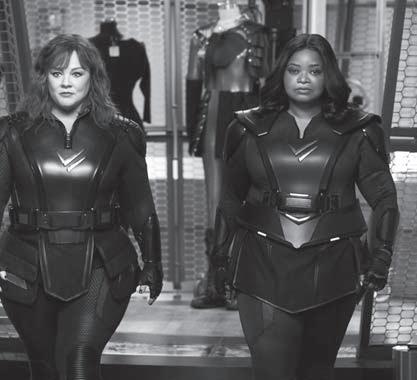
Emily and Lydia must face the leader of the Miscreants, The King (Bobby Cannavale), who is running for mayor in an attempt to conquer the city. But, yet again, the film misses out on an opportunity to showcase the various superpowers Miscreants possess. Although one of The King’s minions, The Crab (Jason Bateman), elicits a few laughs with his self-deprecating humor and attempts to tame his maniacal boss’ temper, the majority of the time these characters aren’t funny or compelling.
Thunder Force is an attempt at a comic superhero film, but it fails to offer any depiction of the mayhem Miscreants are supposedly causing in the city or the chaos the heroes will have to combat. The only indication of the peril Lydia and Emily will have to face are snippets of news reports scattered throughout the film and a brief scene in the beginning showing one Miscreant shooting blue lasers from the back of a pickup truck—setting the tone for an underwhelming superhero storyline. The rest of the film remains underwhelming, so be your own hero and save yourself from watching this movie.
Taylor Swift’s ‘Fearless’ Evokes Nostalgia
BY LAUREN JASEN Heights Staff
Swifties around the world have been patiently awaiting the release of Fearless (Taylor’s Version) ever since the rerecording of the album was announced by the singer. After much anticipation, Taylor Swift released the album this Friday. It consists of 26 songs total—six of which had previously never been released.
When Swift was a bright-eyed singer, she signed with Big Machine Records in 2005 before switching to Universal Music Group’s Republic Records in 2010. Big Machine Records still owns the original recordings of her first six albums, and when music manager Scooter Braun acquired the label, he sold these recordings to Shamrock Holdings for a reported $300 million in 2019. Since this acquisition, Swift promised she would rerecord those six albums, beginning with Fearless.
As Swift described in a tweet, Fearless is an album that depicts both the “bliss and devastation of youth.” She intended to keep the essence of the album as close to the original as possible. There were no changes made in the lyrics or the musical stylings.
As a result, it is rather difficult to distinguish between the original and the rerecording, but there is a certain maturity and richness in her voice that inevitably results from a decade of experience in the music industry. Her youthful lyrics about first
loves, heartbreak, and self-discovery take on more meaning now that she’s reached this new stage in her life.
Where she does add some nuance is in her six new tracks, which are a blend between Fearless’ country tones and Folklore’s dreamy indie-pop tones in terms of acoustics.
“I’ve decided I want you to have the whole story, see the entire vivid picture, and let you into the entire dreamscape that is my Fearless album,” Swift wrote to fans in the same tweet. “That’s why I’ve chosen to include 6 never before released songs on my version of this album. Written when I was between the ages of 16 and 18, these were the ones it killed me to leave behind.”
“You All Over Me,” the first of these songs to be released, is a piece about the heartache that follows a breakup. The charming track features Maren Morris on backing vocals. Swift also teams up with Keith Urban on “That’s When,” a song that isn’t monumental in terms of lyrical composition, but is rather heartfelt and reminiscent of Swift’s early country years.
In “Mr. Perfectly Fine,” Swift sings about people unexpectedly changing. “We Were Happy,” “Don’t You,” and “Bye Bye Baby” follow similar themes of heartache, ultimately highlighting the naivete of youth.
On this rerecording, Swift triumphantly takes on the suits of the music industry, hoping to reshift the artistic and commercial power back to the artists and give them the



opportunity to control the future of their own music. She has been a trailblazer in this pursuit and has sparked many conversations regarding artistic ownership.
In addition, Swift has given fans the opportunity to do something that seems rather impossible: go back in time and relive the magic of this album. Listening to the album, it is difficult not to be transported to your childhood bedroom, listening to Fearless with friends from an iPod as you navigate your young lives and innocent romances.
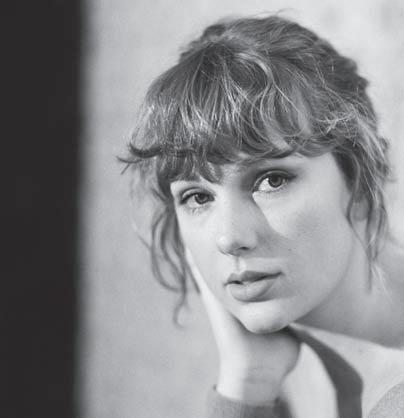
On one of Fearless’ more popular tracks, Swift gets to reminisce about her adolescent life on her hit “Fifteen” as she sings, “When you’re fifteen, feeling like there’s nothing to figure out … this is life before you know who

MUSIC
you’re going to be.” It leaves listeners to wonder if this question still remains unanswered for her. She couldn’t have foreseen her incredible success or the remarkable influence she would have on the music industry.









Swift is certainly a musical pioneer who’s mastered the skill of connecting with many different audiences. No matter what age you are or how many heartbreaks you have had, it is impossible not to feel a spark of nostalgia when you hear the opening to “You Belong With Me,” “Love Story,” or “White Horse.”

We are living in a time when we are constantly trying to look forward to a more hopeful future. This album reminds us that sometimes it is just as important to reflect on the past and all we have to be grateful for.
Surfaces released “Wave of You,” the first single off their upcoming fourth album, on Friday.
The pop duo consisting of Forrest Frank and Colin Padalecki found massive success with their beachy and groovy song “Sunday Best.”

This popular single has now amassed over 630 million streams on Spotify.
The good vibes the two Texas natives have become known for are again overflowing on “Wave of You.” The song sounds like a perfect summer anthem meant to be blasted in the car, with its bouncy backing beat and airy guitar chords.
The album cover is classic Surfaces, as it features a minimalist wave and sunset colored by an array of pastel colors.
At its core, the song is a sweet and heartfelt love song driven by a shimmery electric guitar and hiphop-inspired beats.
A chorus swells in the background, adding an elevated layer to the song.


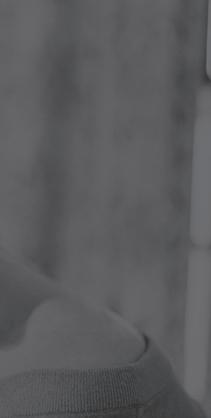


The harmonies and melodies bubble up and effortlessly flow together.
The lyrics perfectly fit the feeling of the music, as the pair sings “I don’t know how I can be so drawn into you / I think I’m fallin’ in deep / I think I’m caught up in a wave of you.”
Brockhampton Closes Boy Band Chapter
BY GRACE MCPHEE Heights Staff
What exactly makes a band a “boy band?” Perhaps it’s uniform dancing, youthful harmonies, or a primarily teenage audience fawning over members in hysterical fashion. Maybe it’s simply the presence of five or more “boys” in the group itself or the collective group emitting a certain pop-music sound. There doesn’t seem to be a particular set of criteria that defines a band as a “boy band,” but despite the commercial success that usually accompanies the moniker, the label has become one that is strenuously avoided by some bands that want to be considered “serious” musicians.
BROCKHAMPTON, however, is not one of those bands. Rather than steer clear of the label, the band leans fully into the boy band persona in an attempt to redefine its meaning. Founded in 2010 by singer
Kevin Abstract, the 13-member collective is defined by its abundance of diversity. The current lineup consists of vocalists Abstract, Dom McLennon, Matt Champion, Russell “Joba” Boring, Ciarán “Bearface” McDonald, and Merlyn Wood; producers Romil Hemnani, Jabari Manwa, and Kiko Merley; designers Henock “HK” Sileshi and Robert “Roberto” Ontenient; photographer Ashlan Grey; and manager Jon Nunes.
BROCKHAMPTON is not your typical boy band for reasons that extend beyond its large size. The band is diverse in its members’ array of different races, sexualities, musical stylings, and overall outlooks on their future in the music industry. The band’s tenure comes to a close with its final and most recent album release ROADRUNNER: NEW LIGHT, NEW MACHINE, which debuted on Friday.
It’s nearly impossible to classify BROCKHAMPTON’s music into one genre given
the wide variety of styles showcased across its six previous albums, but hip-hop probably best represents the band’s focus. Its music is characterized by aggressive rap and deeply introspective lyrics alongside poppy melodies and feelings of self-loathing. The band’s music has swayed between darker and lighter tones as they mature together as a band and independently as artists. BROCKHAMPTON’s 2018 album iridescence was energetic. Its 2019 album GINGER was filled with lyrical poignancy interwoven with smooth rap. ROADRUNNER: NEW LIGHT, NEW MACHINE is an impeccable mix of the two previous albums’ styles.
ROADRUNNER starts off rough with the opening track, “BUZZCUT” featuring rapper Danny Brown. Released as the first single off the album at the end of March, “BUZZCUT” is a distinctly angry track. Layered over scratchy-sounding backing tracks, the band speeds through rap lyrics that disclose struggles with identity, race in America, its place in the music industry, and even a mention of the pandemic as the band sings, “A platinum record not gon’ keep my black ass out of jail” and “I love my mother, drove all the way to Cali’ just to check up on me / Made her go home, felt the virus.”


While this has worked in the past for BROCKHAMPTON—see “BERLIN” and “NEW ORLEANS” off of iridescence—listening to “BUZZCUT” is sort of like listening to nails on a chalkboard. That’s not to say the lyrics aren’t great—they are—but the song is lacking with its chaotic blend of beats on its backtrack. Thankfully, the album picks
up following the ending of “BUZZCUT.” “CHAIN ON,” featuring rapper JPEGMAFIA, is a smooth-sounding track full of clever and powerful wordplay backed by a catchy electro riff and Abstract’s gruff vocals channeled into the song’s chorus. As McLennon raps, “Hangin’ from a chandelier in Babylon / We don’t believe in white gods, they gettin’ rattled on.” McLennon’s voice is saturated in austerity and pride while he sings on this track. “CHAIN ON” is a song that shows the band members contemplating the state of the world. It isn’t just a song that should be listened to, but also one that requires contemplation over topics like the political and racial polarization in America.
The rest of ROADRUNNER follows suit, drawing listeners into the band’s lyrical precision and vulnerabilities. Standouts include the single “COUNT ON ME” as well as “DON’T SHOOT UP THE PARTY,” the former of which is a wildly catchy tune about old friendship and features lyrics co-written by A$AP Rocky and vocals from Shawn Mendes. In comparison, “DON’T SHOOT UP THE PARTY” is a sardonic plea about gun violence and racism in the United States, on which Abstract opens the song rapping “All-American self-hatred runs deep / White boys all I see whenever I sleep.”
Ultimately, ROADRUNNER is a perfect exit for BROCKHAMPTON. With over a decade of trailblazing behind it, the group finally finds its identity, as the album hones its hip-hop sound on its way out. Although the band will be missed, its music will live on in infamy—as many of the best boy bands’ music does.

‘THE MELTING OF THE SUN’ ST. VINCENT
St. Vincent released a music video for her new single “The Melting of the Sun” in an animated style reminiscent of Schoolhouse Rock! and other retro cartoons.
The nostalgic animation is fairly consistent throughout the music video.
It features cartoonish drawings of characters, beach scenes, and illustrations alluding to drug use—with a few divergences from this format to show St. Vincent herself, singing and strumming her guitar in front of psychedelic backdrops.

The video comes together into a kaleidoscope of trippy and colorful visuals.
This retro style isn’t unusual, but unlike many other artists, St. Vincent employs this format and style effectively.
The strangest visual has to be that of St. Vincent’s actual face superimposed on top of a melting sun.
Her face also reappears, but this time it’s glistening in the light of a cigarette.
Aside from the various cartoon elements featuring St. Vincent, the image of a pill bottle being spilled in reverse is a distinct visual, but there are only hints of meaning behind it.


But, that’s all that can really be said for any of the visuals featured in the music video.
There are images hinting to car crashes and drug overdoses, such as the spilled pill bottle, scattered throughout the video.
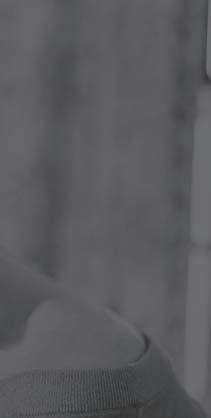
These images, however, are spliced haphazardly together and seem random and disassociated.






Although these images provide unique details, they offer a fragmented story without leaving much of an impression.
While the visuals grab the viewer’s attention and portray the style of the song, there is no cohesive component that brings together the music video’s storyline.
THE HEIGHTS
PHOTO COURTESY OF NETFLIX
DISTRIBUTED BY NETFLIX RELEASE APRIL 9, 2021 OUR RATING MOVIE
‘THUNDER FORCE’ BEN FALCONE
PHOTO COURTESY OF REPUBLIC RECORDS
‘FEARLESS (TAYLOR’S VERSION)’ TAYLOR SWIFT DISTRIBUTED BY REPUBLIC RECORDS RELEASE APRIL 9, 2021 OUR RATING
PHOTO COURTESY OF DEF JAM RECORDINGS ‘ROADRUNNER: NEW LIGHT, NEW MACHINE’ BROCKHAMPTON DISTRIBUTED BY DEF JAM RECORDINGS RELEASE APRIL 9, 2021 OUR RATING
MUSIC
MONDAY, APRIL 12, 2021
‘WAVE OF YOU’ SURFACES KIERAN WILSON
A10 BY KATHERINE CANNIFF Assoc. Arts Editor
CHARLEY CONROY
SINGLE REVIEW
MUSIC VIDEO
BY AIDAN ABDO Heights Staff
Not much has gone right for Boston College baseball in the last few weeks. The Eagles have gone deep into their bullpen game after game but can’t seem to find the magic formula.
After dropping the first two games of their weekend series to NC State (14-11, 8-10 Atlantic Coast), the Eagles (1416, 4-14) were in desperate need of a win.
Unlike BC, however, the Wolfpack is trending upward, as NC State came into the game as one of the hottest teams in the country with nine wins in their last 11 games. What resulted followed the team’s trajectories to a tee, and BC fell 7-0 at home.
The Eagles have struggled against ACC opponents and, with their loss on Saturday, dropped below .500 for the first time this season. Going into the second half of the season, the Eagles don’t have much time left to turn things around, and a series sweep shows no signs of improvement.
“This game and series was definitely big for us,” BC head coach Mike Gambino said in his postgame press conference. “However, all these games are big for us. Our backs are up against the wall right now.”
Right-handed graduate transfer Alex Stiegler put together one of his best out-
ings of the season. He pitched 7.2 innings, recording six shutout innings and 11 strikeouts.
NC State right-handed freshman Matt Willadsen continued his strong rookie season with his best outing of the year. He pitched a complete-game shutout and only gave up two hits. Willadsen’s dominance, combined with a rough bullpen outing for BC, led to the completion of the weekend series sweep for the Wolfpack.
Although he was up against one of the best offenses in the ACC, Stiegler used the breaking ball to get the Wolfpack hitters off balance and rolled through the first inning with two strikeouts. Although he gave up a double to left fielder Jonny Butler to start the second, Stiegler got out of the inning with no damage.
Stiegler continued to roll through batters in the third and fourth innings. He ended the third inning with a breaking ball to make the Wolfpack batter fall to his knees for strike three. He kept his momentum up, recording seven strikeouts in just four innings.
“Both [Stiegler] and Emmet [Sheehan] pitched great for us this weekend,” Gambino said. “We needed [Stiegler’s] length today, and he got us to the spot that we wanted going into the eighth inning. … It stinks that his great start was wasted.”
Willadsen’s first inning, on the other hand, was a little shaky. After recording an
infield single on his first at-bat, Sal Frelick stole second to get into scoring position early. Willadsen then gave up a walk to Cody Morissette, giving the Eagles a chance to get on the board early. The pitcher worked through the jam seemingly with ease and exited the inning unscathed.
He rolled through the Eagles’ batters with command of his pitches and a great defense behind him. In the fourth inning, Morissette hit a hard chopper to first, but Austin Murr snagged it and got the force out to start the inning.
Both pitchers kept rolling through the fifth and sixth innings keeping the game scoreless. Willadsen was so dominant that at one point in the game he retired 16 batters in a row.
In the top of the seventh inning, Butler once again ripped a double to right field. From there, designated hitter Terrell Tatum laid down a bunt that advanced Butler to third and allowed him to reach first safely. Third baseman Vojtech Mensik then grounded out to the pitcher, which advanced Tatum to second and allowed Butler to score the first run of the game.
NC State’s bats stayed hot in the eighth when Wolfpack batters Murr and Luca Tresh both singled and stole a base to put runners at second and third with two outs. Gambino then decided to go to freshman lefty Charlie Coon out of the bullpen.
Coon walked his first batter of the day to load the bases. From there, shortstop Jose Torres ripped a double into deep left field sending all three runners home to make the game 4-0.
Facing a growing deficit, the Eagles still could not get going against Willadsen and the Wolfpack defense. In the seventh, Gold hit a rocket to the left-center gap, which Butler snagged. The Eagles even tried pinch-hitting freshman Travis Honeyman in the eighth to no avail.

Although Coon started the top of the ninth with a strikeout, lefty Joey Walsh relieved him after Coon gave up another walk. The Wolfpack loaded the bases against Walsh as well after an error and a walk. This time, it was Tresh who took advantage with a double to left-center field, sending home all three runners to make the game 7-0.
Although the Eagles loaded the bases in the bottom of the ninth, Willadsen finished his shutout by striking out Jack Cunningham to end the game.
Gendered Language Undercuts Women’s Sports
Olympic weight racks as far as the eye can see.
The NCAA chalked it up to a lack of space, but Sedona Prince, a player for Oregon women’s basketball, posted a TikTok showing off an equally sized room adjacent to the women’s practice court that the NCAA had left empty.
Before the NCAA could even explain its reasoning for the weight room differences, private vendors such as Dick’s Sporting Goods had done more to right the ship than the tournament’s presiding organization by offering up weight room equipment.
The discrepancies in the weight rooms—and the NCAA’s lack of a response—are indicative of a larger pattern at the NCAA Tournaments. The men’s tournament hardwood proudly displays the words “March Madness.”
The floors of the women’s venues, on the other hand, are emblazoned with “NCAA WOMEN’S BASKETBALL” in all caps—no indication that it’s on the same competition or excitement level as the men’s tournament.
Both tournaments take place mostly
in March, and based on the fact that both of last Sunday’s games came down to a last-second shot, I’d say they’re both pretty full of madness. So why is one tournament a special event with a special name, and the other is just a collection of some women’s basketball games?
The language we use creates an insurmountable divide between men’s and women’s sports, and it prevents women’s sports from gaining the respect they deserve.
It’s probably not possible to completely remove the use of “women’s sports,” but perhaps the problem instead lies in not using a qualifier for men’s sports. By qualifying “women’s sports” as such and men’s sports as just “sports,” we’re using men’s sports as an arbitrary standard of what sports look like.
Since the tournaments’ differences gained significant traction on social media, I’ve seen a major uptick in the equal distribution of qualifiers between men’s and women’s sports. Recent tweets and graphics about the men’s tournament include a men’s qualifier to specify that they’re about the men’s
tournament rather than assuming that the audience uses men’s sports as a basis of comparison.
Still, only 1.6 percent of sports news on Twitter as of last year pertained to sports played by women. And a lot of the time, as we saw in the case of Kershner and Prince, much of that 1.6 percent is work done by women in order to at least defend the little sense of legitimacy afforded to women’s sports.
The NCAA seemed to have not learned its lesson from the backlash over the inequalities in its basketball tournament weight rooms, and sports journalists—many of whom were women—recently took to Twitter once again to call the organization out for its inconsistencies.
The NCAA announced that the first three rounds of the NCAA Women’s Volleyball Tournament are set to take place in a convention hall in Omaha, Neb. Big Ten analyst Emily Ehman reported that eight of the tournament’s practice courts are layered over cement floors, which creates a high risk for injuries. The NCAA also announced that there would be no live commentary on the first two rounds of
the tournament.
Twenty-four hours later, after facing criticism from journalists and sports fans—once again, many of whom were women—on Twitter, the NCAA turned around and announced it would offer live commentary on all of its games.
Although the NCAA eventually got its act together, it did not seem like the organization did so because it wanted to legitimize women’s sports.
Instead, it seemed like the NCAA was just trying to save its own hide rather than making changes because it was the right thing to do.
Another significant portion of that 1.6 percent is hateful and ignorant comments about female athletes. As we’ve known practically since its inception, Twitter provides a veil of anonymity to its users by allowing them to hide behind their usernames and post harmful things without much consequence beyond some angry responses.
There are plenty of people out there who love to share heinous opinions on women behind the shield of Twitter’s relative anonymity, so
their responses should be taken with a grain of salt, but they give a nod to the larger problem at hand.
“It’s a hobbie not a sport, stop posting this shit,” Kevin Dennison, notably without a profile photo, tweeted in response to ESPN’s tweet about South Carolina women’s basketball making it to the Final Four.
In all seriousness, these types of comments are largely a result of the legitimacy which has been stripped from female athletes as a result of the exclusive reliance on the term “women’s sports” and rare use of “men’s sports” in the same capacity.
Until the sports world changes how it qualifies men’s sports, sports played by women will never get the respect and attention they deserve. I’m not advocating against espnW as an outlet to elevate women’s voices and accomplishments, but maybe ESPN—or, sorry, espnM—and other sports powerhouses should put more consideration into how their language surrounding gender in sports reinforces power structures that so many people have been trying to ditch for decades.
Final Four Brings Optimism With Grant Hire
buzzer-beating 3-pointer away from a title game berth.
coaches in the middle of particularly bad seasons, and both schools have had Martin Jarmond serve as athletics director in the last two years.
UCLA’s comeback story starts amid the Jaylen Hands era on Dec. 31, 2018, with the firing of head coach Steve Alford. Murry Bartow served as interim head coach for the remainder of that season before Cronin was hired in April of 2019.
The 2019-20 season started out rough for the Bruins. They fared well against non-conference opponents at the very beginning of the season but began to show weakness against Pac-12 opponents. Four games into conference play, UCLA was 1-3.
UCLA’s rapid turnaround started with its next game—a low-scoring 50-40 win over UC Berkeley. From there, Cronin commanded the Bruins to wins in 10 of their next 12 games. After starting the season 1-3, UCLA finished the regular season with a conference record of 12-6.
Unfortunately for the Bruins, COVID-19 squandered their momentum, canceling the Pac-12 Tournament and derailing their suddenly realizable March Madness dreams that seemed laughable at the commencement of the season.
A year later, UCLA did it—barely. The Bruins made it into the NCAA Tournament after a play-in overtime win against Michigan State as the No. 11 seed. That win was enough for the Bruins, however, as they kept their momentum going throughout the tournament. UCLA eventually earned a Final Four appearance and was just one
Cronin inherited a 17-16 overall UCLA team that had missed the NCAA Tournament entirely the year prior. Now, two seasons later, he led the Bruins to a 22-10 overall record, including NCAA Tournament wins against a No. 2 seed and a No. 1 seed for the second Final Four appearance by a No. 11 seed in tournament history. Had it not been for a questionable charge call and a miraculous buzzer-beater by the No. 1 team in the country, UCLA would have likely played in the national championship game.
UCLA’s rapid turnaround was miraculous, but it did not result in a national championship—at least not yet. Baylor claimed the title instead.
Like Gonzaga, Baylor is no stranger to the NCAA Tournament in recent history. The Bears have appeared in nine of the last 13 tournaments, starting with the 2007-08 season. Before then, however, Baylor’s March Madness success was almost nonexistent. Prior to 2007, the Bears had appeared in just four tournaments, the most recent being in 1988.
Baylor’s key to relevance is Drew, its head coach. In the last 18 seasons under Drew, his squad recorded 16 NCAA Tournament wins. In the 65 seasons before him, Baylor only had three. While it took Drew five seasons before making it to March Madness, getting there was a remarkable feat given what he was up against.
In 2003, Baylor’s then-head coach Dave Bliss was fired facing allegations of player compensation amid a scandal involving the murder of a former Baylor player by one of Bliss’ players at the time.
The Baylor team Drew inherited was limited to seven scholarships for the first two years of his time as head coach and was barred from the postseason his first season with the team. The NCAA also barred the Bears from non-conference games during the 2005-06 season, extended the team’s probation, and limited its recruiting abilities.
Despite this adversity, Drew still managed to lead Baylor to its first NCAA Tournament appearance in 20 years in 2008. Now, still under Drew’s command, the Bears are national champions.
BC’s situation is somewhere in between that of UCLA and Baylor. While the Eagles lack UCLA’s reputation as a basketball powerhouse, they also lack probation and any recent scandals. BC finished last season with an overall record of 4-16, but it has not been that
long—three years, to be exact—since the Eagles finished their season with an overall winning record.
While BC has had some recent success, Grant has a lot on his plate. All four of BC’s 2020-21 leading scorers—Jay Heath, Wynston Tabbs, Rich Kelly, and CJ Felder—are currently in the transfer portal, and BC’s only constant over the last four seasons—Steffon Mitchell—is moving on after this year.
BC’s biggest problem, however, is the simple fact of its two conference wins last season.
Grant said he knows it will be an uphill battle and has acknowledged the program might not see success at first, but he is capable of leading BC to a fast rebuild. He has done it before, after all.
When Grant started his last job at Charleston in 2014, he inherited a team with a 6-10 conference record the season
prior. In his third season, Charleston’s conference record improved to 14-4, and a year later in 2018, the Cougars made their first NCAA Tournament appearance since 1999.
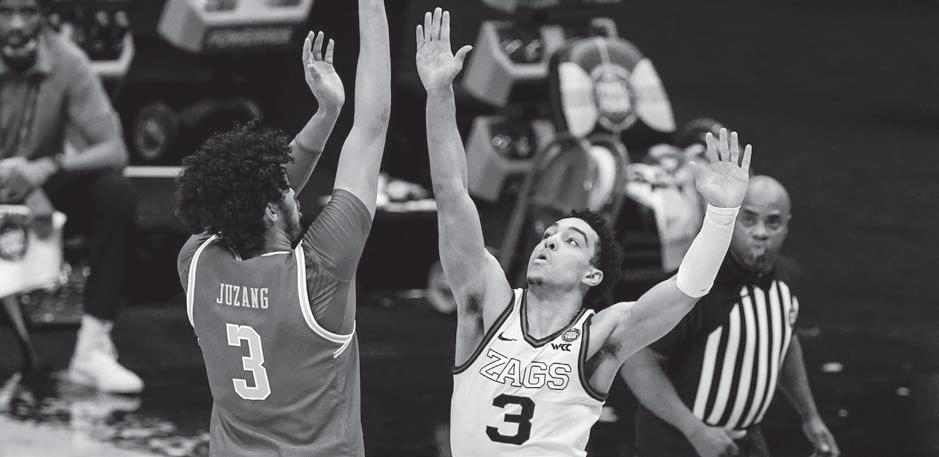
Charleston is a Colonial Athletics Association team without much historic success in sports. BC plays in the most competitive conference in the nation, the ACC, and has a sports culture backed by decades of success across the board—basketball included. The Eagles have not played in an NCAA Tournament since 2008, but they have appeared in 18 historically and have played in three Elite Eights.
Lots of Eagles have had success in the NBA, including names like Jared Dudley, Dana Barros, and John Bagley. While basketball is often treated as secondary to football and hockey, it has the potential to be big again at BC.
A11 THE HEIGHTS MONDAY, APRIL 12, 2021
NC State Boston College 7 0
MICHAEL CONROY / AP PHOTO
Willadsen’s Two-Hit Shutout Silences BC Bats
The 2021 March Madness Final Four proves that a new head coach can make all the difference in a team’s success.
IKRAM ALI / HEIGHTS EDITOR
Even power hitter Cody Morissette couldn’t muster a hit against Matt Willadsen.
Women’s Sports, from A12 Head Coaching, from A12
Most people, without question, would say that the greatest female athlete of all time is Serena Williams, with her world-leading 23 Grand Slam titles. No other person—male or female—has accomplished what she has. Still, though, she’s not the “GOAT”—not because she’s not the Greatest Of All Time, but because her title always includes the qualifier of “female” in front of it.
When you turn on the TV, your options are ESPN and espnW (with the “W” standing for “women”). You watch the NHL or the NWHL and the NBA or the WNBA. At many high schools and colleges, the male athletes are called by their school’s mascots, while the female athletes are the “lady” mascots—think “Hawks” v ersus “Lady Hawks.” We wouldn’t call them the “Gentlemen Hawks” because it sounds silly, so why use “Lady Hawks?”
I can see the argument for wanting to differentiate between men’s and women’s sports in order to not use men’s sports as a basis of comparing their accomplishments. The fact that Katie Ledecky’s 1500 meter freestyle world record is 49 seconds slower than Sun Yang’s on the men’s side doesn’t make Ledecky’s feat any less impressive, for example.
But there are ways to differentiate the two other than relying so heavily on the alienating qualifier of “women’s sports” and labeling those same sports played by men as just “sports” with no qualifier.
The placement of one word seems minor—and in terms of sentence structure it is—but in terms of the connotations associated with it, adding a qualifier for one gender and not another to our language about sports has done more harm than good.
The men’s and women’s basketball NCAA Tournaments recently came under a microscope after the circulation of a video comparing the men’s and women’s weight rooms.
Ali Kershner, a performance coach for Stanford women’s basketball—the eventual national champion—tweeted out a photo of the women’s “weight room”—a single rack of dumbbells and a handful of yoga mats—comparing it to that of the men—a conv ention hall-sized room filled with
BY ASA ACKERLY Assoc. Sports Editor
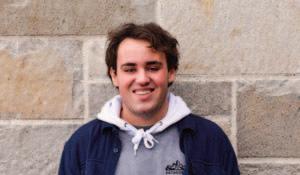

J aw-dropping goal totals have been something of Boston College lacrosse star Charlotte North’s staple in her time on the Heights. To earn her 47 goals up to this point this season, she has scored over six goals on four separate occasions, including an eight-goal performance to open the year against Albany.

Still, the hope of breaking the Eagles’ single-game scoring record of nine goals has remained elusive despite North’s consistent high-octane play. She finally broke through on Saturday afternoon, as she scored 10 goals against Virginia Tech to set a new program record for BC (9-1, 5-1 Atlantic Coast). North’s record-setting performance led the way in the No. 4/5 Eagles’ 21-11 rout of the Hokies (3-8, 0-6).
Former BC star Sam Apuzzo held the previous record after scoring nine against Navy in 2018. Jenn Medjid tied the record last month with a stellar display against Louisville.
T H E THE N O R T H NORTH S T A R STAR


Smith
North tied Apuzzo’s record 10 minutes into the second half on a rocket past Virginia Tech goalie Angie Benson off a free-position shot. The shot gave BC a 15-7 lead and was the fourth in what turned out to be a run of five straight goals for the Eagles. The streak put the Eagles comfortably in the lead after the Hokies had cut their deficit to just three in the early minutes of the second half.
As the clock wound down in the later stages of the second half, the Eagles continued to extend their lead, but North’s hope of securing the record looked bleaker with every passing minute. Belle Smith got on the board three times after North’s ninth goal, and Cara Urbank and Cassidy Weeks also found the back of the net, but North’s name stayed off the stat sheet.
North finally secured her spot in the annals of program history in the final seconds. Freshman Kit Arrix carried the ball into the Hokies’ third and dished it to a cutting North who picked up the ball and flicked it into the top of the net with just one second left to play.
North was also dominant on faceoffs, as she tied her career high with 13 draw controls.
North got off to a fast start, opening the scoring just over a minute into the game as she wrapped around the net and fired a jump shot to the right of Benson.
The Eagles and Hokies went back and forth for most of the half, until the Eagles took a commanding 9-4 lead with a trio of unanswered goals to end the half.
North not only ran up the scoreboard but did so in style, as she ripped one of her first-half goals on a behind-the- back shot.
Virginia Tech opened the second half with two quick goals to cut the Eagles’ lead to three, but BC’s five-goal run put the game out of doubt for most of the second half.
The Eagles’ commanding lead also gave them the opportunity to give backup goalie Abbey Ngai a couple minutes between the pipes. Ngai started as a sophomore but has seldom seen the field over the last two seasons due to the emergence of Rachel Hall, who transferred to BC from Oregon.
New head coaches can turn basketball programs around within just a few years, and with any luck, Boston College could be next. Scott Drew did it for Baylor, Mick Cronin did it for UCLA, and Earl Grant did it for the College of Charleston.
BC men’s basketball has not made a March Madness appearance since 2009. Since then, the Eagles have played 11 seasons under three different head coaches while missing both the NCAA Tournament and the NIT each season. The firing of Jim Christian marked—hopefully— the end of a dismal chapter in BC men’s basketball history, and as the program turns the page with Grant’s hiring, BC has the rare opportunity for a fresh start.
This year’s NCAA Tournament was a prime example of programs that have undergone rapid transformations competing among the best. To see the new head coach effect on full display, you don’t have to look any further than this season’s Final Four: Baylor, UCLA, Houston, and Gonzaga.
Neither Baylor nor UCLA were in the 2018 NCAA Tournament.
Houston did make an appearance that year, but it was its first NCAA Tournament in eight seasons. Gonzaga has been a college basketball powerhouse for most of recent history, but that has not always been the case.
Prior to Mark Few’s hiring at Gonzaga in 1999, the Bulldogs had played in just two NCAA Tournaments since the start of the program in 1907. Since Few came aboard, the Bulldogs have competed in every NCAA Tournament—all 21 of them. Gonzaga experienced its rapid ascent decades ago, but the rest of the Final Four experienced transformations far more recently.
UCLA is the latest beneficiary of the new head coach effect. The similarities between its program and BC’s are also undeniable. Both programs have a depth of history—UCLA with the most NCAA Tournament championships in all of Division I and BC with a breadth of March Madness experience and success—but have struggled in recent years. Both programs have recently fired their head
Anderson’s Dominance Evens Syracuse Series
BY SAM ARCAMONE Heights Staff
Traditionally, pitchers get tired. Repetitive motion tends to have that effect.
But that does not seem to be the case for Boston College softball’s Susannah Anderson. She told the American Journal of Sports Medicine’s decades of research to go take a hike, pitching over 20 combined innings this week, with her last pitch seemingly clocking in as fast as her first.
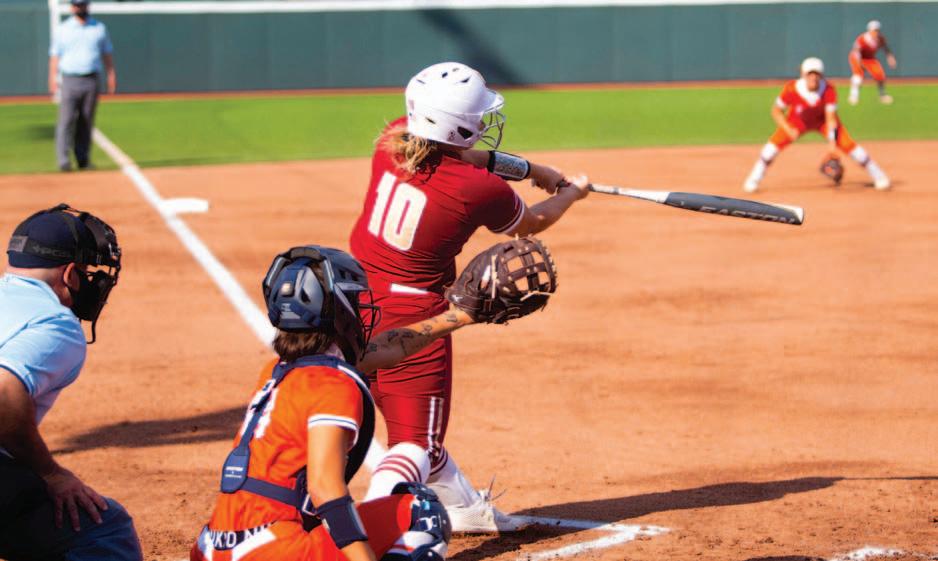
Following a four-out save in game one of Saturday’s doubleheader, Anderson retook the circle in a complete-game victory, holding a formidable Syracuse offense to one run in the Eagles’ 3-1 win.
The Orange came out hot. After Paris Woods’ ground ball rolled underneath Nicole Giery’s glove, Gabby Teran advanced her with a groundout to Emme Martinez.
Neli Casares-Maher, Syracuse’s three-hole hitter and owner of a .351 batting average entering the game, smoked a ground ball into Anderson’s right leg, putting runners on first and third with one out.
Lailoni Mayfield followed suit, hitting a grounder that tipped off Anderson’s glove, allowing Woods to score. Anderson rebounded and
retired Angel Jasso and Toni Martin in succession, limiting the damage to one run.
Six of the next seven batters for both teams grounded out.
The Eagles then got their bats going in the bottom of the second.
Gianna Randazza, BC’s right fielder, began the inning with a flyball to center field.
It appeared to be a can of corn for Martin, the Orange’s center fielder, only a few steps from her original fielding position.
Then, left fielder Woods jogged over with the ball in midair. They could have had a conversation in the time Randazza’s flyball stayed in the air—and maybe they did. Which of the two of them was going to catch the ball, however, could not have been a topic of discussion, as the ball dropped in between them.
Djhane Valido hammered an opposite-field double into the right-center gap a couple of batters later, arriving at second as Randazza advanced to third. After Kamryn Warman fought off an inside fastball and popped out foul, Gianna Boccagno stepped up.
Boccagno took the first pitch for a ball and fouled off the second. Orange pitcher Kaia Oliver’s third pitch, with the intent of hitting the outside corner, ended up far too close to the center of the plate.
Boccagno connected, sending a

Elisabeth Laviolette followed Boccagno to continue the Eagles’ two-out rally. Laviolette delivered, driving a liner to the right-center wall, good for a double.
The Orange executed the relay perfectly, and the ball passed from Martin to Casares-Maher to catcher
Ellie Mataya singled up the middle to lead off for the Eagles. With one out, Giery walked up to the plate. On the
As Syracuse’s Barnes popped out to cement a BC victory, the radar gun on Anderson’s pitch read 66 mph—the MLB equivalent of 93 mph—after pitching 20.1 innings on the week.
A12 THE HEIGHTS
MONDAY, APRIL 12, 2021
KRISTIAN LAMARRE / HEIGHTS STAFF
Charlotte North broke the three-year-old program record for singlegame goals with 10 to lead the way over Virginia Tech.
College 1 3
Syracuse Boston
line drive up the middle and just by the outstretched mitt of the diving second baseman Teran, scoring both runners.
Maxine Barnes in a matter of seconds.
Boccagno was out at home, but the Eagles ended the inning with a 2-1 lead.
Anderson sat the Orange’s batters down 1-2-3 in the top of the third.
Picking up where they left off, the Eagles put up another run in the bottom of the frame.
second pitch, she pulverized a fastball down the line, scoring Mataya from first. After three, BC led Syracuse 3-1. Anderson didn’t allow a run in the next four innings, despite a runner being in scoring position for each one of them.
was BC’s second leading scorer with five goals, and Jenn Medjid added three of her own along with a trio of assists.
EMMA HEALY “Hire” Elevation Over Qualified See Women’s Sports, A11 See Head Coaching, A11
ETHAN OTT
MAGGIE DIPATRI / HEIGHTS EDITOR
Gianna Randazza’s flyball double set up the Eagles’ first score of the game, and BC defeated Syracuse 3-1 to finish the weekend.
/HEIGHTSSTAFF
Boston College Virginia Tech 21 11











 BY MEGAN KELLY News Editor
BY MEGAN KELLY News Editor
































































